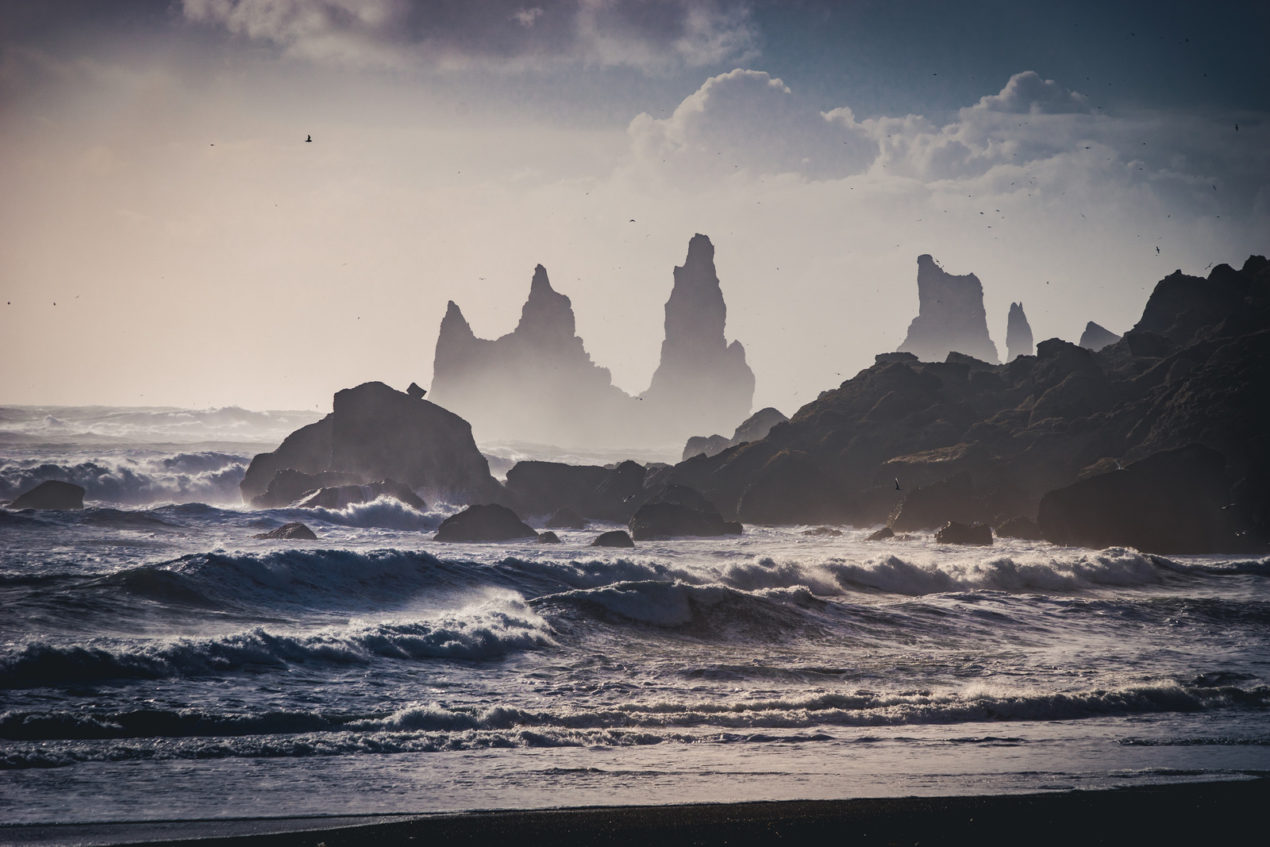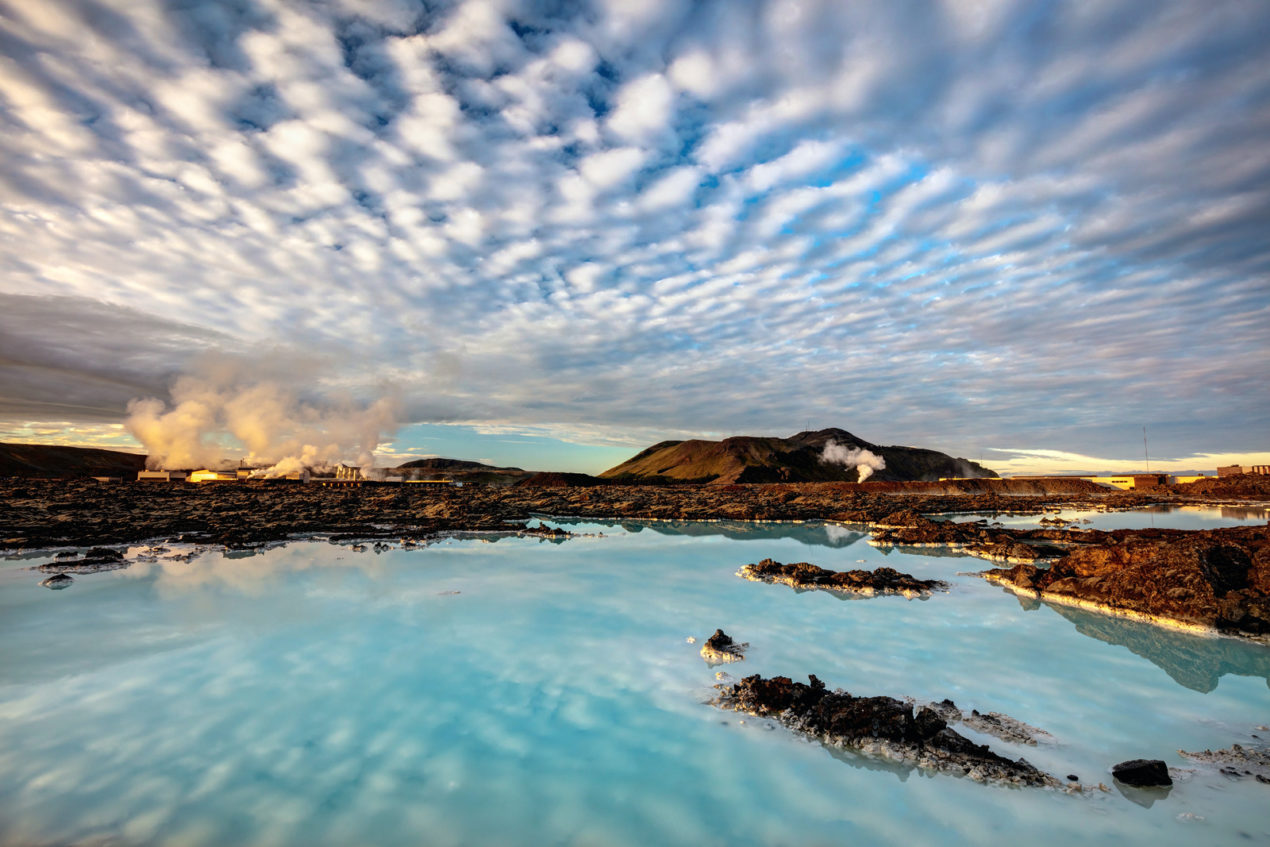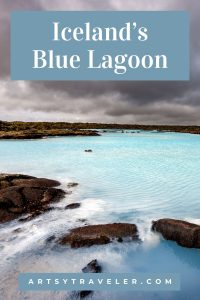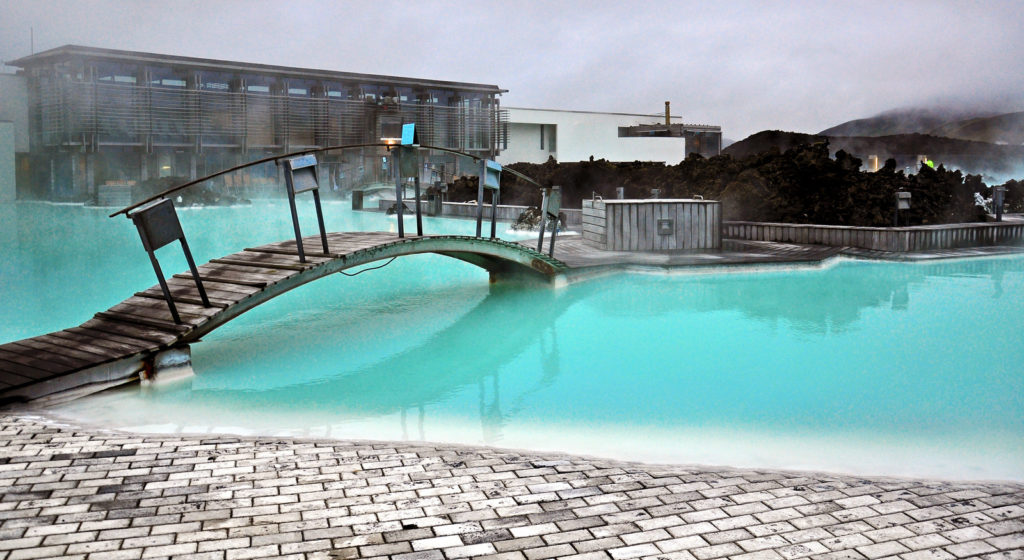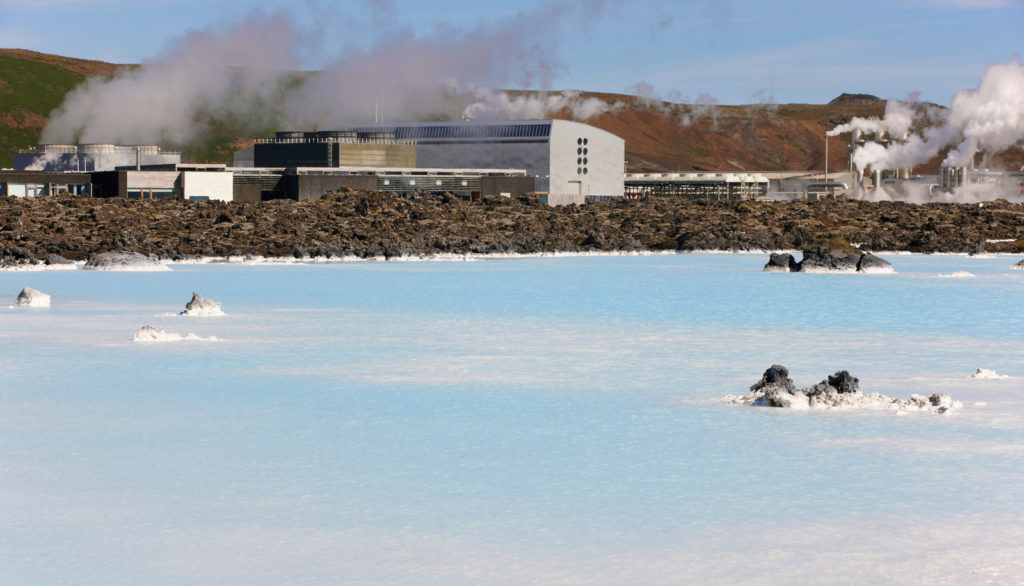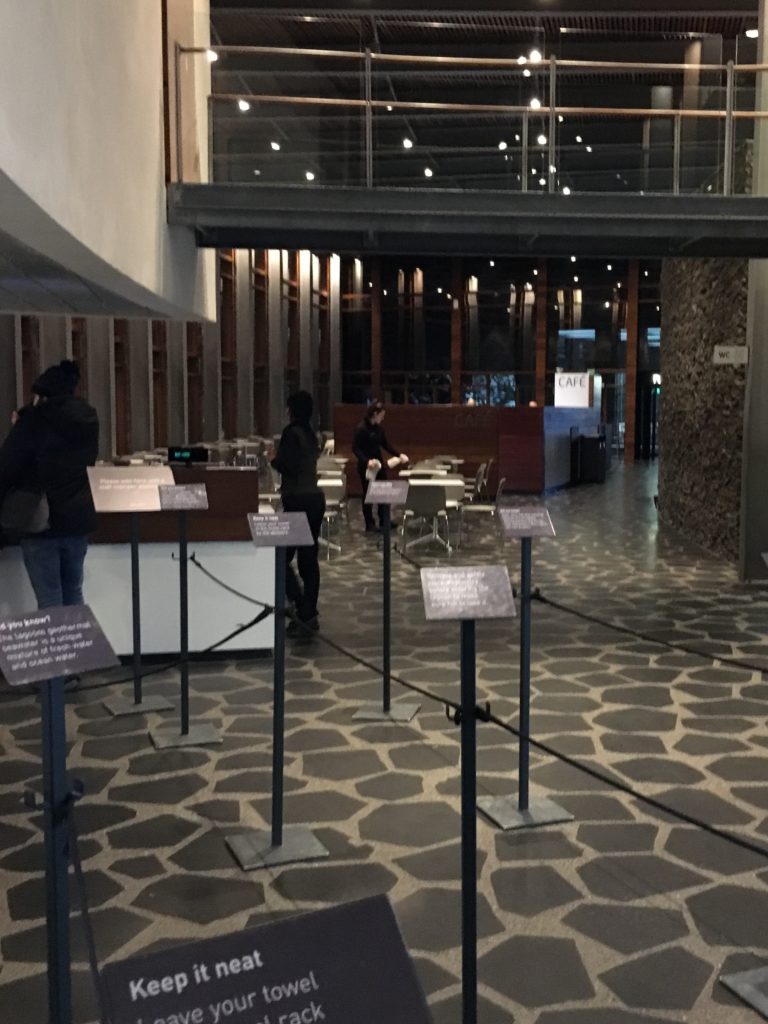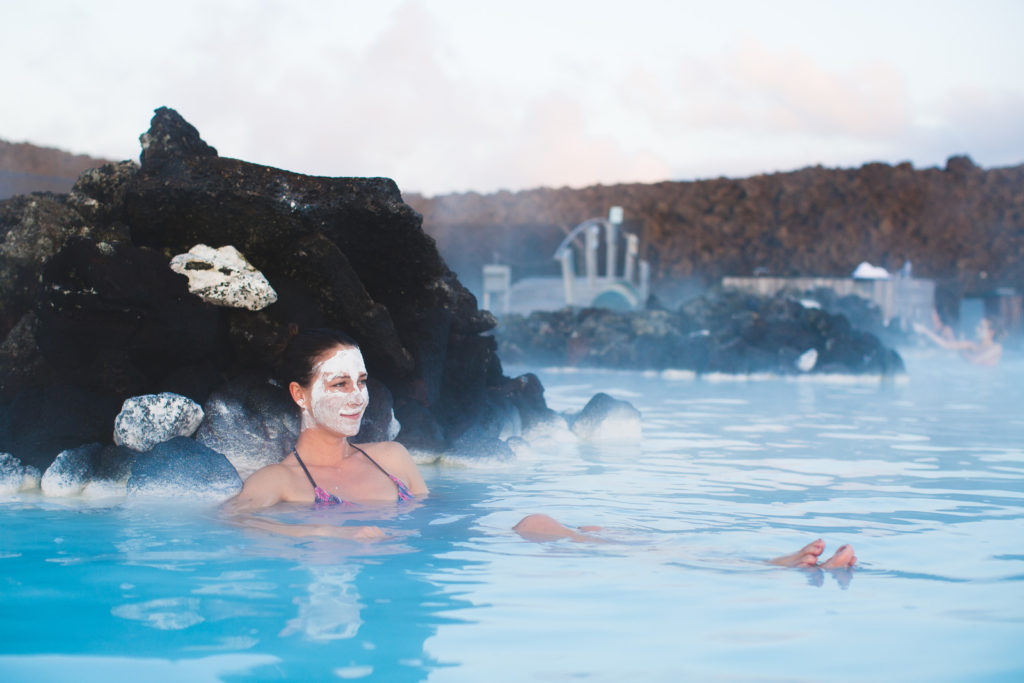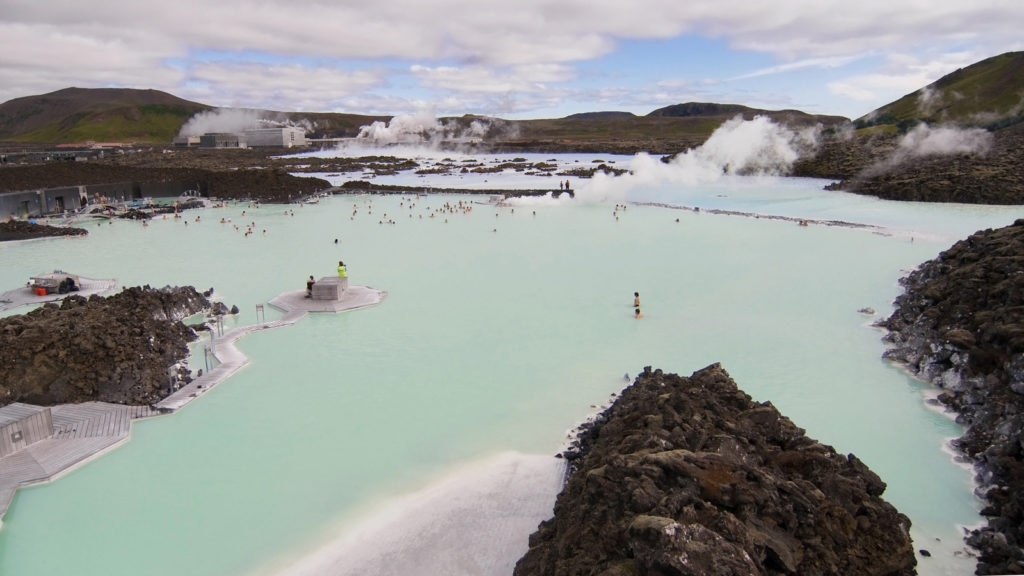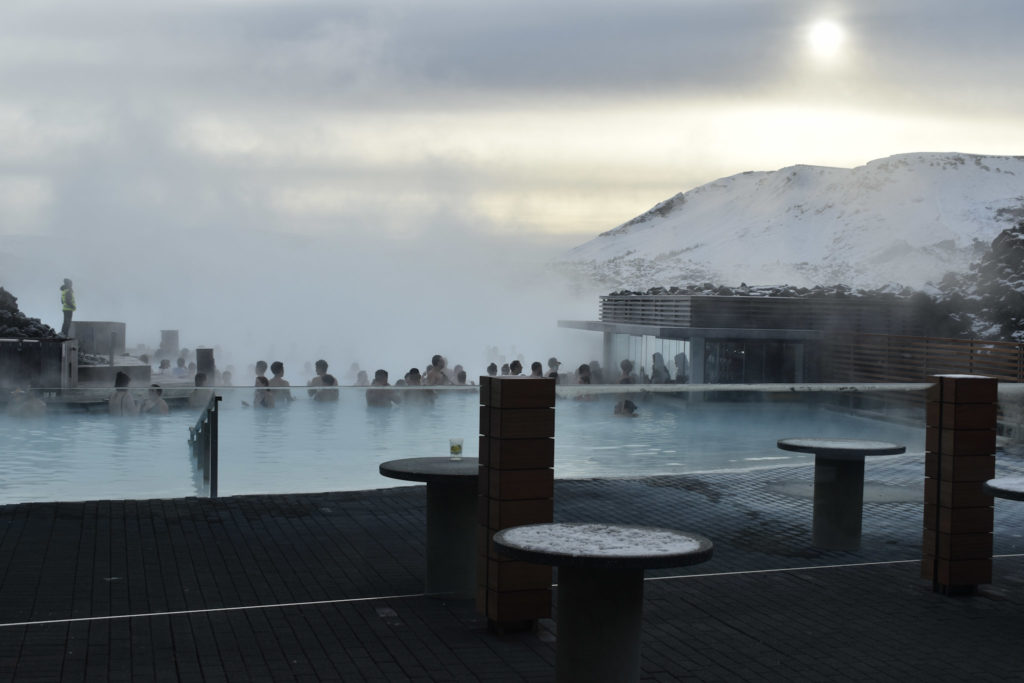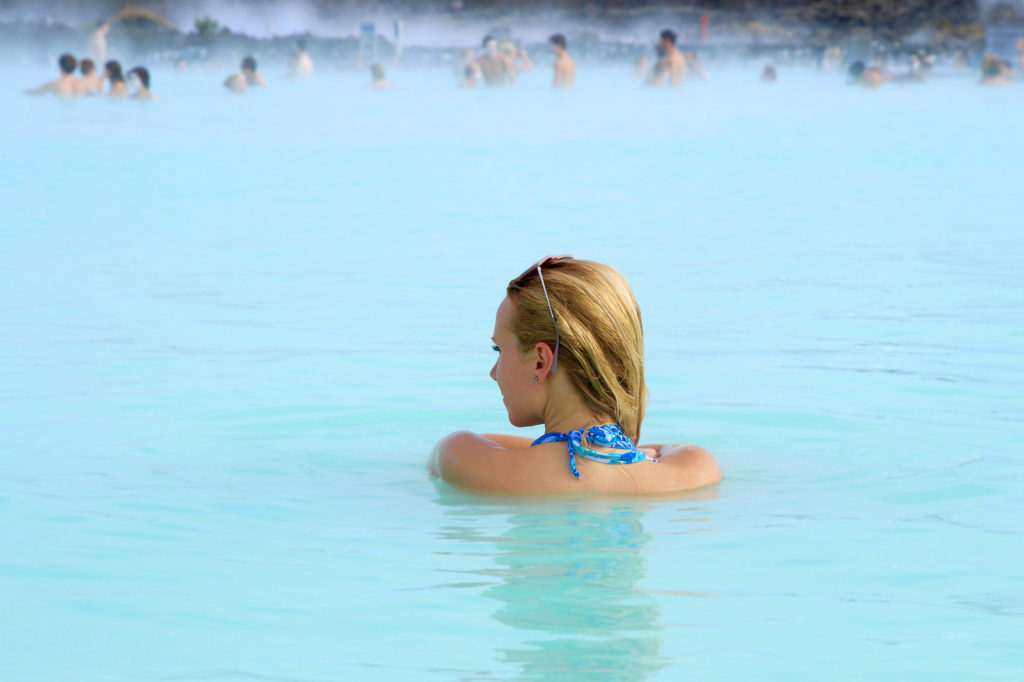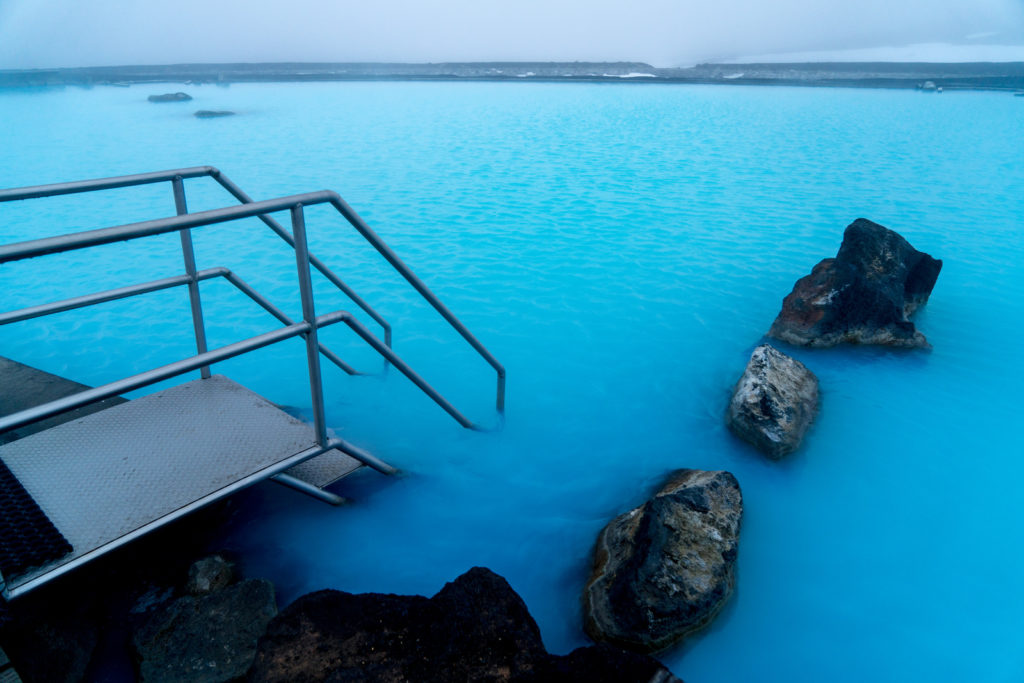Best of Iceland on An 8-Day Ring Road Tour
If you’re planning to visit Iceland, take time to circle this most amazing country on a ring road tour.
How about visiting in February? Yes, please! You have a good chance of seeing the northern lights, the days are getting long enough to allow for a good eight to ten hours of daylight sightseeing, the crowds are almost non-existent, and the weather is… Yeah, well, it’s cold. But it’s February. Dress warmly and you’ll be fine.
We booked the Circle of Iceland in Winter 8-Day Guided Adventure with Guide to Iceland. Their website is easy to navigate and includes plenty of reviews.
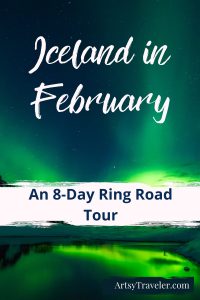
Scroll to the end of this post to view other tour ideas.
Day 1: The Golden Circle & Horseback Riding
Our Iceland Journey Begins
At eight o’clock on a dark, cold, wet, and very windy morning, we trundle our suitcases from Hotel Ódinsvé along quiet streets to the bus stop next to Hallgrimskirkja, the massive church that dominates the Reykjavik skyline (“kirkja” means church).
Along with dozens of other shivering tourists, we wait for our tour bus to arrive.
Over the next forty minutes, bus after bus pulls up, a guide hops out, calls a few names, and then drives off to begin tours ranging from a day trip around the Golden Circle to a full-on ‘around Iceland’ tour.
After thirty minutes, I start to worry that I got the place or the time wrong. Maybe we’ll be stranded here in the cold for the next eight days. The crowd starts to thin. Just a handful of people remain when a bus pulls up and out jumps a man about my age. He calls my name and I want to fall into his arms and kiss him.
I don’t, of course. Which is just as well since later I find out that he’s happily married with seven children.
Onto the Bus
We clamber onto the 16-seat bus, nod greetings to the few people already on board and take the two seats three rows from the front.
We drive off into the darkness, stopping a few more times to pick up our tour mates. By the time we’re done, the bus contains 15 people, including us: six people from China (two other mother-daughter couples), one couple from India, one couple from Australia, and three single women—a fellow Canadian from Quebec, a woman from Norway, and one from Germany..
Julia and I, along with the two Aussies, are the only people on the bus for whom English is our first language, which I find interesting.
Leaving Reykjavik, the Capital of Iceland
The bus stops at a gas station on the outskirts of Reykjavik, and our guide/driver, Jon, introduces himself. He’s a retired policeman and an experienced driver. I get the sense that he’s not to be messed with. He tells us that the road to Þingvellir (pronounced Thingvellir), our first stop on the Golden Circle, is closed. Great! Maybe we shouldn’t have come to Iceland in February.
Will we spend our vacation sitting in a gas station parking lot?
Jon tells us to relax and go with the flow. It’s Sunday morning and cars routinely get stuck in the snow on the road going over the mountain between Reykjavik and Þingvellir. He advises us to grab a coffee and buy spikes if we haven’t already.
Spikes are steel-studded rubber slip-ons you pull over your boots to prevent falling on the ice. We already have our spikes, but most other people don’t. Jon also sternly warns us in what I take to be his policeman voice to NEVER wear spikes in the bus.
Julia and I chat with the women from Norway and Quebec. The Norwegian woman is writing a book about Iceland. Throughout the trip, she sits at the front of the bus eagerly questioning Jon and taking notes.
On the Road to Þingvellir
Jon gets word that the road to Þingvellir has opened so we set off. It’s still pretty dark at about 9:30 am, but as we drive out of the city and across rolling, icing-sugar hills, the sky begins to lighten.
To the east, a narrow slit of sun-tinged blue slices apart clouds the color of grey wool socks. The vistas are dreary and stunning at the same time.
We pass the largest freshwater lake in Iceland and are informed that we are driving on the North American side of the tectonic plates. Soon, we’ll cross to the Eurasian plate. At Þingvellir, the two plates rise above ground. You can walk (or snorkel) between them.
Jon tells us that at the time of Settlement (871±2), trees covered 40% of Iceland. Within 200 years, most of the trees were cut down for firewood and to make way for sheep. Now, only about 2% of Iceland is tree-covered.
We stop for photos just as the sun blasts through the clouds. Julia takes her first of many (many) pictures featuring her crocheted dolls of Jon Snow and Daenerys Targaryen of Game of Thrones fame.
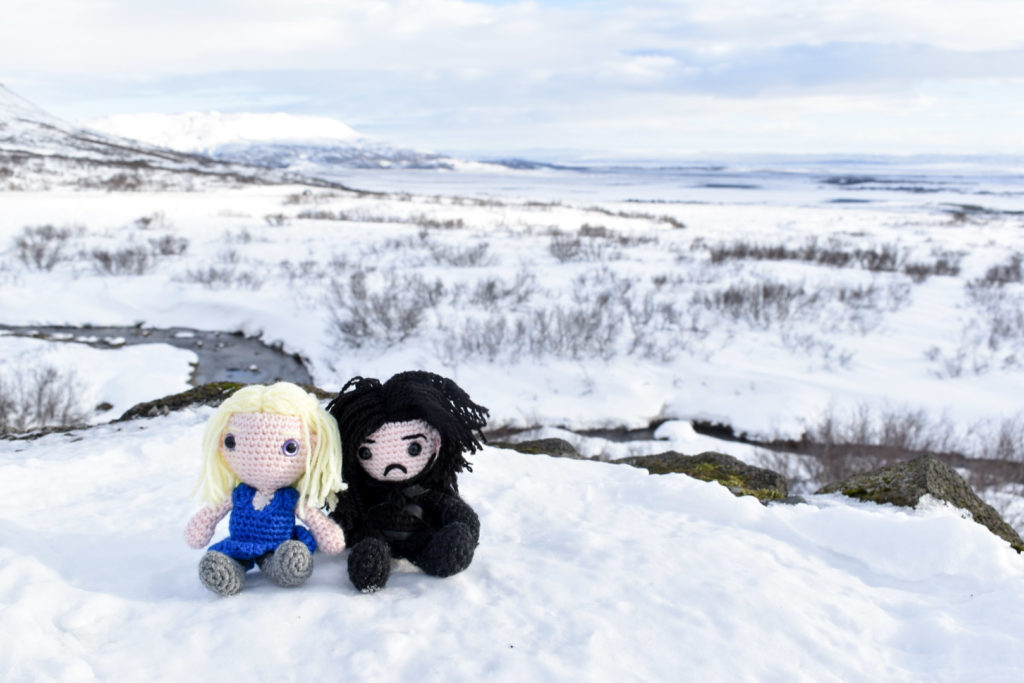
Julia is a crochet artist who runs an online business selling her patterns and dolls. To learn more, check out Wayward Pineapple Creations. I’ll include more of her Jon and Daenerys photos in this post.
Iceland’s Famed Golden Circle
Three major sites comprise the Golden Circle: Þingvellir National Park, Geysir Thermal Area, and Gullfoss, a dramatic double waterfall. Pretty much every visitor to Iceland who stays more than a few hours makes the trip around the Golden Circle. As a result, the three sites are mobbed, even in February.
For more about the sites on the Golden Circle see Travel in Iceland: Top Tips for an Awesome Trip.
Riding on Icelandic Horses
After our stop at stupendous Gullfoss, we head south toward the Ring Road. Our destination is a stable that offers rides on Icelandic horses. The horseback riding activity is one of the optional tours we’ve added to our main tour package. Julia and I have signed up for every optional tour with the exception of the whale watching. Julia gets seasick even on the dock, so we figured a boat ride was not advisable.
Icelandic horses are small, shaggy, sturdy, strong, and absolutely adorable. The Icelandic horses you’ll see running across the landscape all over the country are direct descendants of the horses the Vikings brought to Iceland at the time of Settlement in 871±2.
Mounting the Horse
The young woman who will be our guide leads a beautifully disheveled, long-maned horse towards me and introduces her as Heklava.
I put my foot into the stirrup, rise up, and then quickly realize I’m in trouble when my leg won’t respond to my command to throw itself over Heklava. What am I thinking? I’m no longer young and I’m definitely no longer light, even after shedding 17 pounds in preparation for this very thing.
For months, I’ve been motivated by the prospect of riding an Icelandic horse. Every time I craved something fattening, I imagined the furry little guys and how humiliated I’ll be if I’m unable to get on one, or worse, I make it collapse under my weight. They are sturdy, but how sturdy?
In a momentary loss of confidence, I say to the guide “I don’t think I can do this.”
She tells me to try again and with a clenching of abs that would make any Pilates instructor swoon, I hoist myself high enough to fling a leg over poor, unprotesting Heklava. I wonder what she’s thinking. Probably about the oats she’ll get in an hour after patiently trotting the chubby Canadian through hurricane-strength gusts.
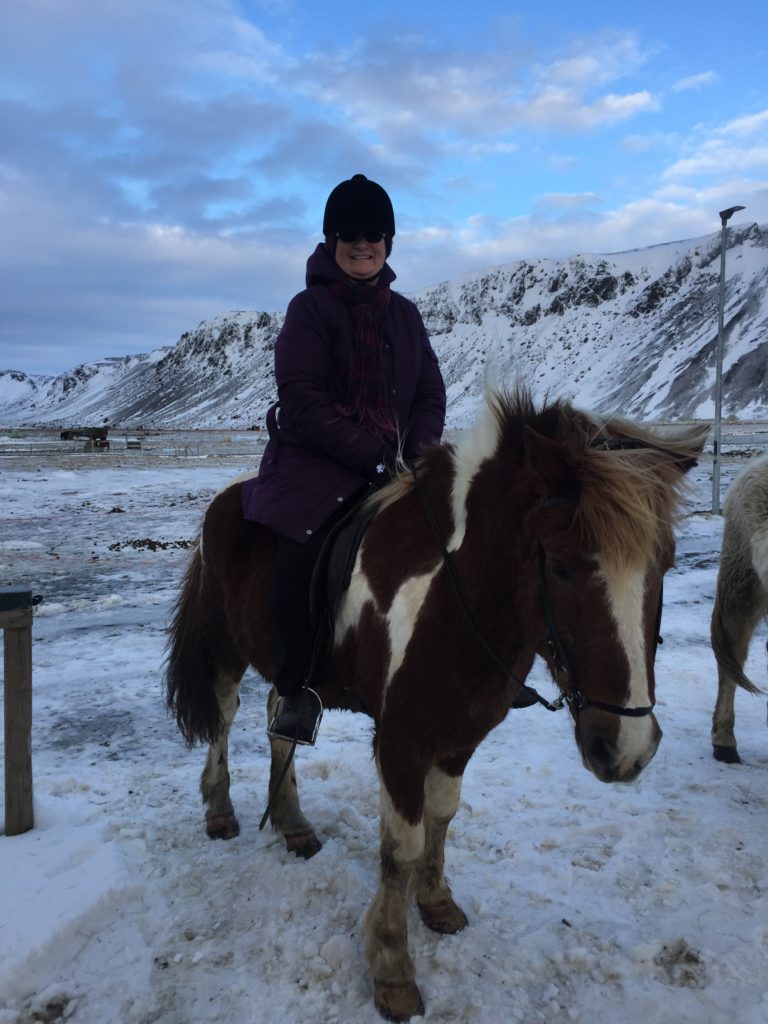
I’m on top of the world! The guide tells me how to hold the reins, says to pull left for left and right for right, and then tells me not to worry about it. The horse will just follow the horse in front of her. Heklava certainly seems very docile which is just fine with me.
Setting Off Across the Windy Valley
We set off. The wind sweeps across the valley, almost knocking me from Heklava who barely flinches. I wonder if it’s possible to be blown off a horse and renew my frantic clenching of abs and thighs.
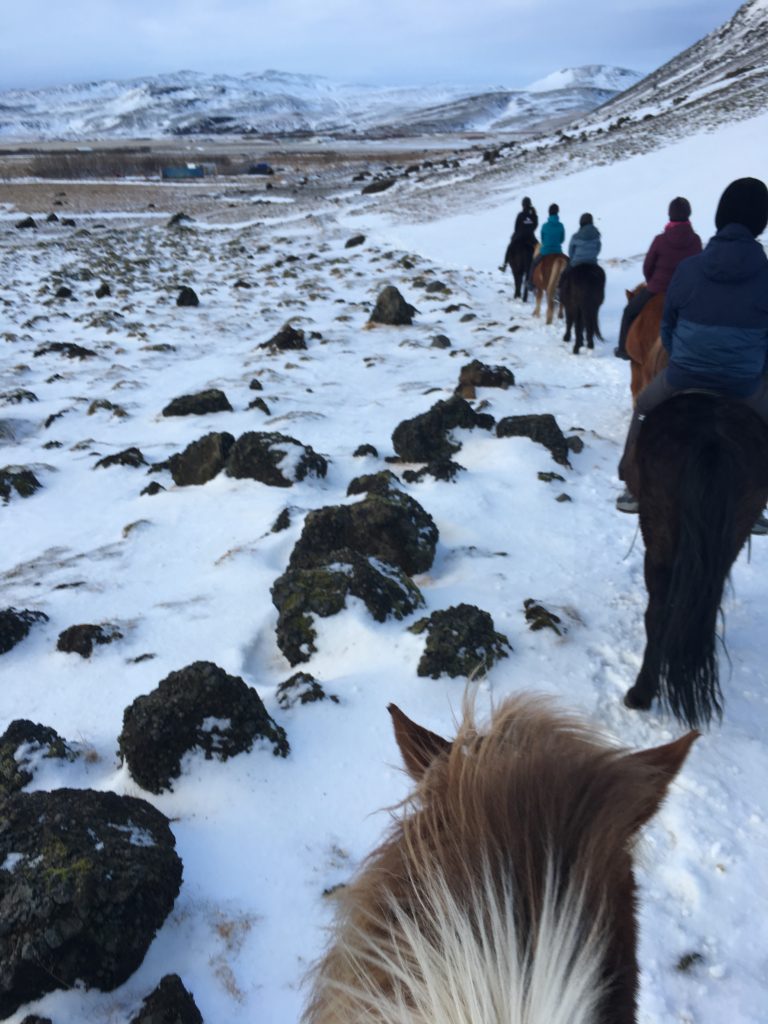
I start off right behind the guide as we head out along a path leading up a snowy ridge. My cheeks are burning with cold, but I’m too afraid to release my death grip on the reins to adjust my scarf—as if Heklava would make a run for it if I wasn’t hanging on for dear life. Somehow, I doubt it. She’s more interested in nuzzling the butt of the horse in front of her, probably in search of warmth.
I sympathize.
We walk at a sedate pace through glorious, snow-dusted countryside flooded with golden afternoon light. During the few moments when the wind gusts die, the experience is heavenly—a gentle, ambling stroll on a Viking horse across land settled by Vikings.
I embrace my inner Norse person. Actually, I’m not sure I have any Norse DNA, but for one glorious hour atop Heklava, I am Freya, the ancient goddess of love, sex, beauty, and fertility.
Heading Back
On our way back to the stables, the guide turns around and tells us that we’ll trot the rest of the way.
No!!
Heklava follows the lead of the horse ahead and soon I’m bouncing around like a demented rag doll. Will my health insurance cover a fall from a horse?
Back at the stables, I slide off Heklava and, losing my balance for a few mortifying seconds, stagger across the corral—more a drunken female Bacchus than a stately love goddess.
Heklava does not spare me a backward glance as she clomps with gloomy forbearance into her stall and sets to work eating hay.
Evening at Fosshotel Hekla
On the way from the stables to our hotel near the small town of Hella, we pass a point where the winds are said to be the strongest in Iceland (which is saying something).
Wind is a constant in Iceland. It blasts your eyes, freezes your skin, rips car doors off their hinges, and turns horseback riding into an ordeal.
Fosshotel Hekla is a stylish place with a good restaurant and an outdoor hot tub. After dinner, we crunch through the snow under a full moon to reach the hot tub. Submerged to our necks in warmth, we stare up at the Icelandic sky with gratitude for a perfect Day 1 of our tour.
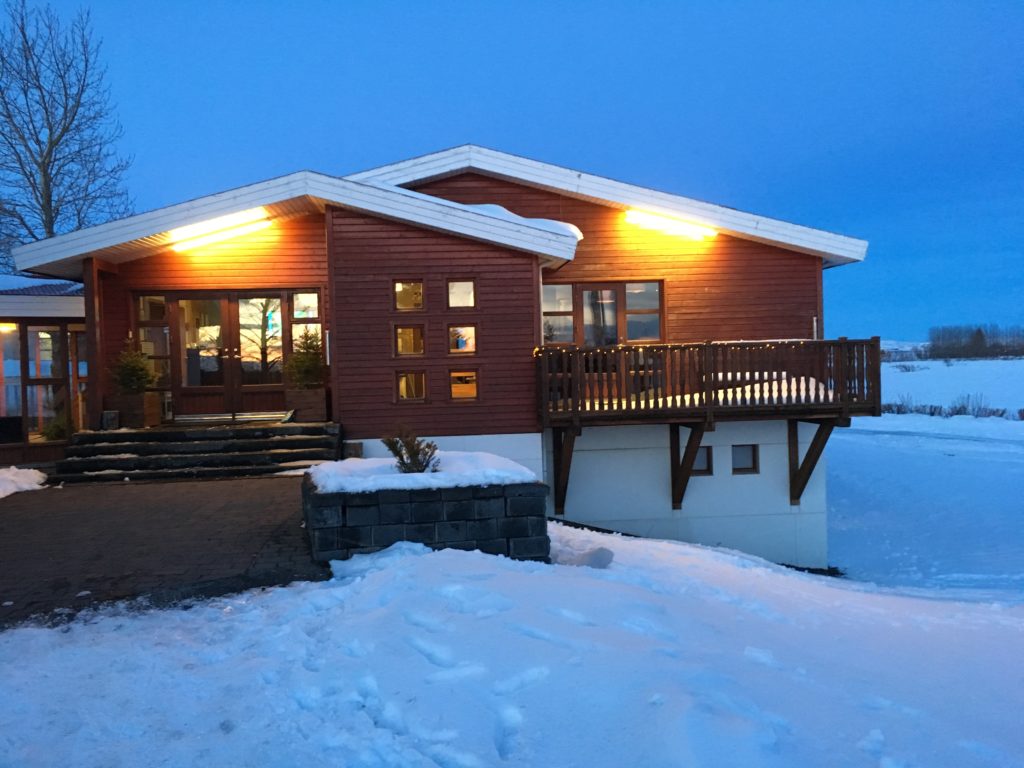
We’re told that the northern lights are due for an appearance around midnight. We try to stay up, but after getting to our room glowing from the hot tub and post-horseback riding exhaustion, we are both fast asleep by 10 pm.
Day 2: Iceland’s South Coast & Glacier Hike
Our first breakfast on the tour is a harbinger of breakfasts to come. It’s fantastic! After avoiding bread for weeks prior to the trip so I wouldn’t be in danger of injuring the Icelandic horse, I have to give in and try the warm bread slathered with fresh Icelandic butter. Heaven!
It’s a very good thing that the horseback riding occurred on Day 1. Now I can scarf down warm bread and butter every morning for the rest of the tour.
The buffet also includes plenty of smoked fish, eggs, fresh fruit, cereals, and oatmeal. No one is going to go hungry on this tour.
On to the Ring Road
We’re on the bus promptly at 8:00 am for the drive south to the Ring Road and then east toward the glaciers. The Ring Road connecting most of the coastal towns in Iceland was not completed until 1974. Before then, people could be pretty cut off, particularly during the winter. Even now, stretches of the road are often closed because of poor weather.
Land of Volcanoes
Looming in the distance as the sun rises is Mount Hekla, a stratovolcano and one of Iceland’s most active volcanoes. Over 20 eruptions have occurred since 874. In the Middle Ages, the volcano was called the Gateway to Hell. We’re told that she (they call her ‘she’) could erupt at any moment.
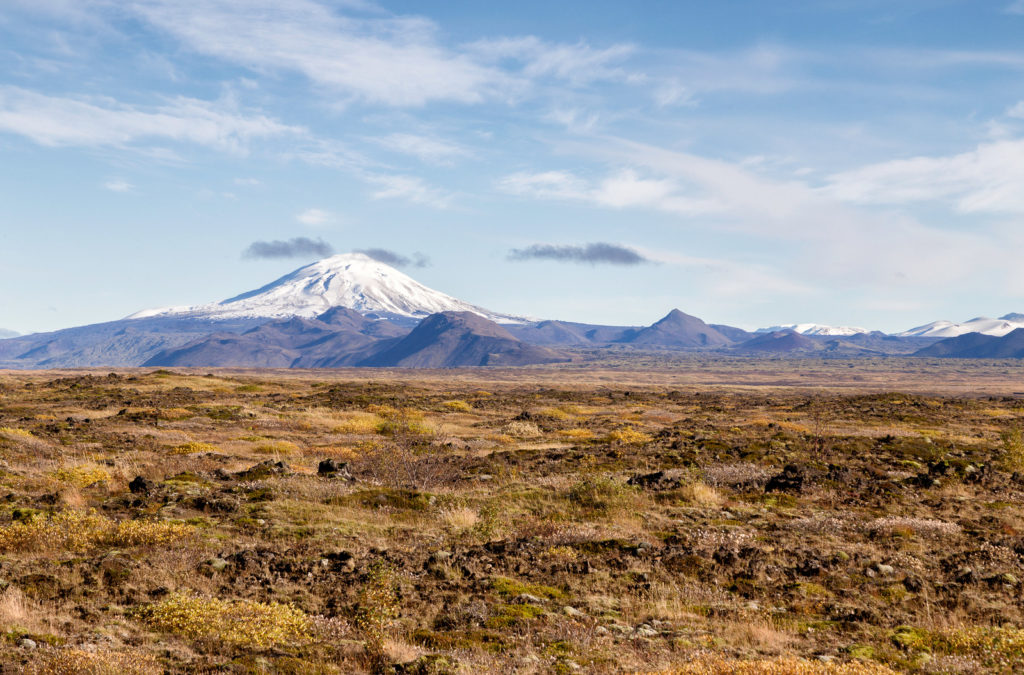
The south coast is bulwarked by mountains, all of which are active volcanoes covered with glaciers.
In 2010, the ice cap Eyjafjallajökull (“jökull” means glacier) that covers the caldera of a volcano, erupted. Air traffic was stalled for six days, and Iceland was put on the map.
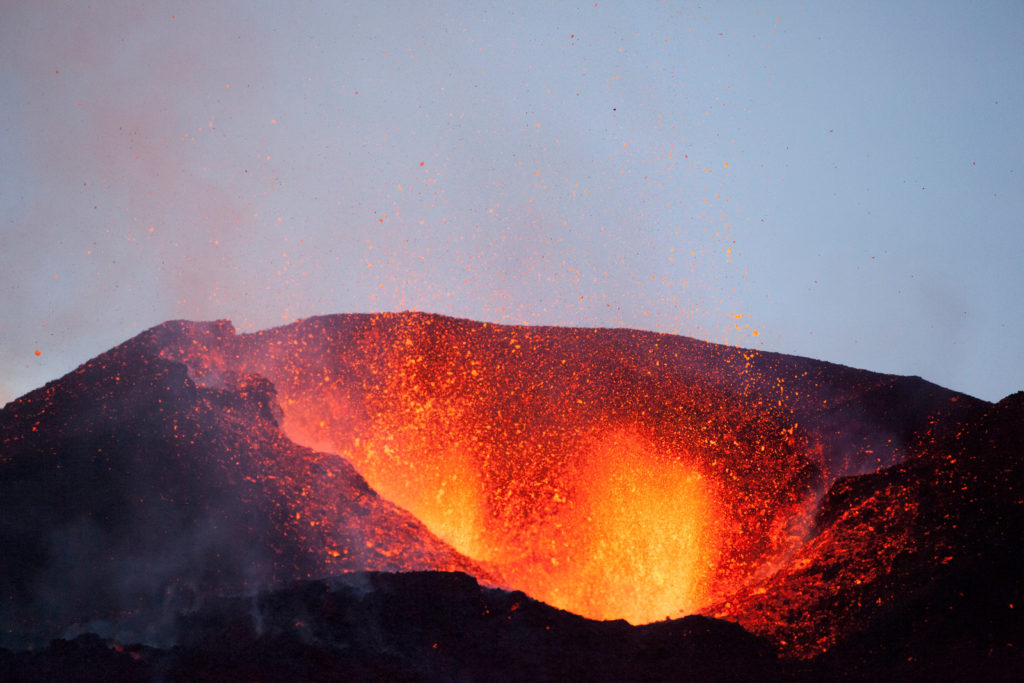
In addition to seeing pictures of the devastation caused by the eruption, the outside world was introduced to the stunning Icelandic landscape. The secret was out. Since 2010, tourism to Iceland has exploded. The country now welcomes well over two million visitors every year.
The weather is glorious—deep blue sky, sun bouncing off glittering glaciers, a bracing wind. We are driving along one of the most spectacular stretches of the Ring Road—glaciers to the left and the rolling Atlantic Ocean to the right. Our guide stops frequently so we can snap photos of the scenery.
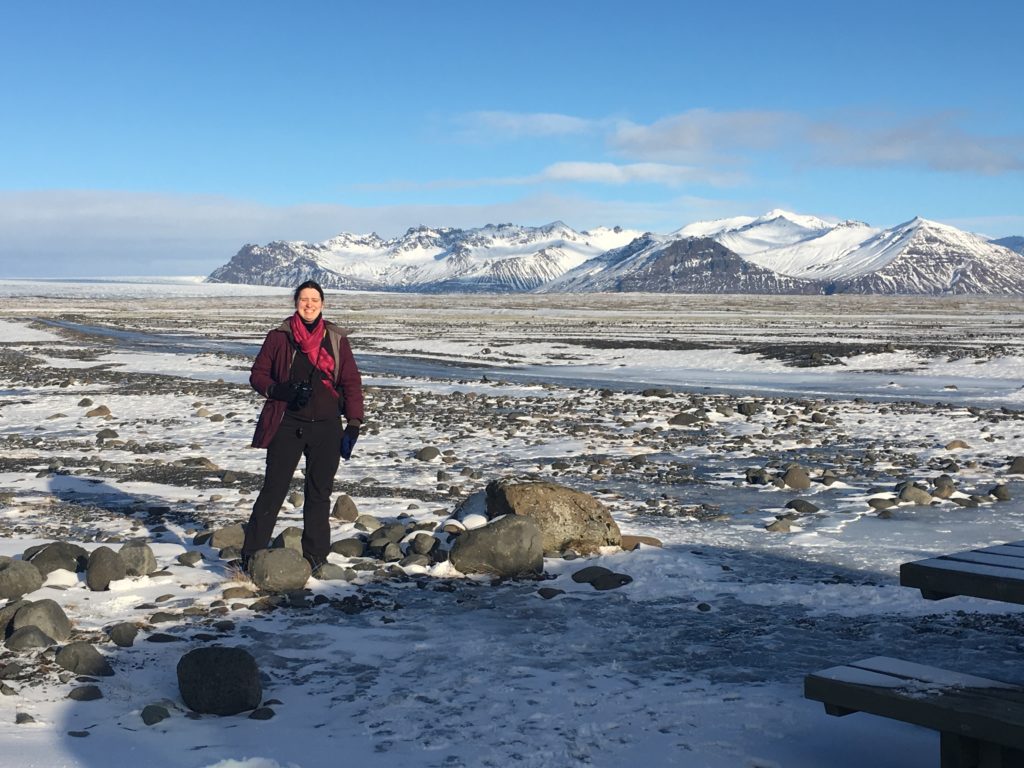
Lava Center
We visit the newly built Lava Center to learn about volcanoes and earthquakes. I find the interactive exhibits fascinating and not a little unnerving. We learn that several volcanoes in the immediate vicinity (not just Hekla) could erupt “at any moment.”
The news is not reassuring.
Waterfalls Seljalandsfoss and Skógafoss
On our way to the scheduled glacier hike, we visit two spectacular waterfalls.
In the summer, Seljalandsfoss can be circled on a path that passes behind it. But in February, the ice on the parking lot poses a significant hazard even with our spikes. I am terrified of falling! Also, the entire waterfall is shrouded in frigid shadow. We take some quick photos and retreat to the bus.
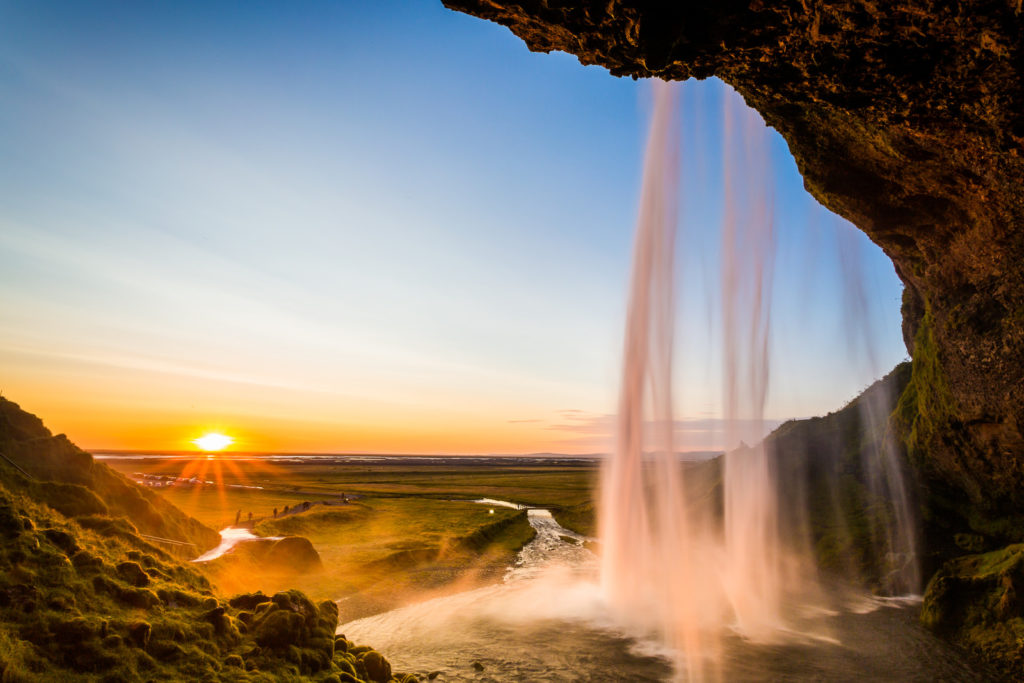
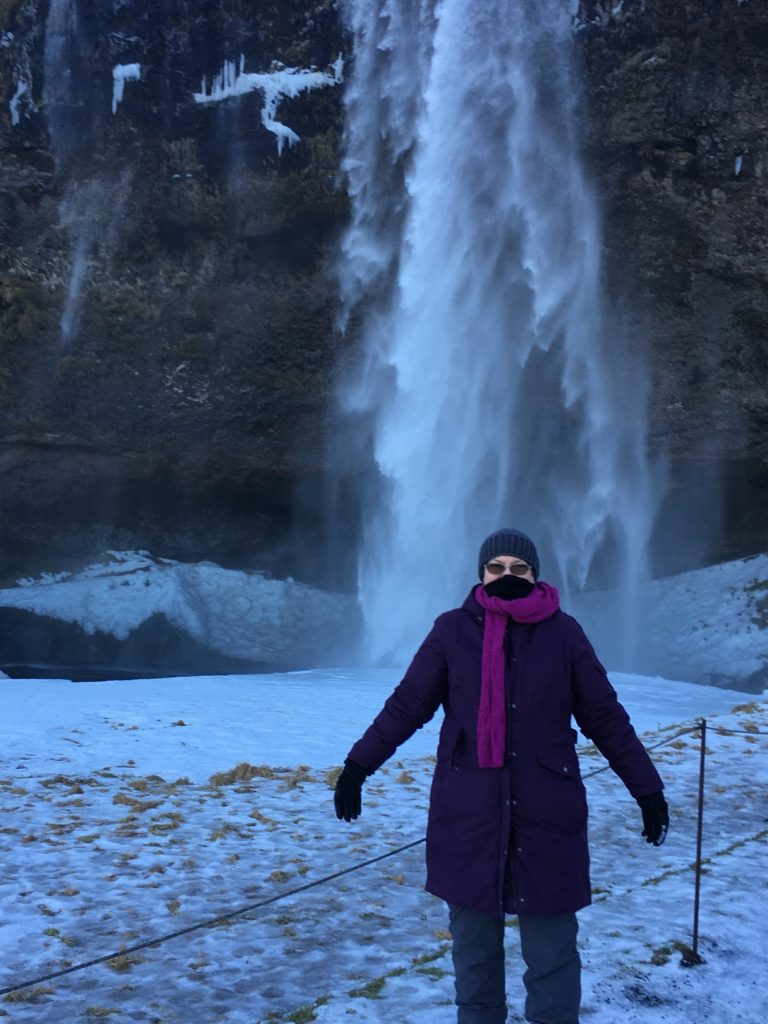
Skógafoss is wider and to my mind more spectacular. Rainbows play across the tumbling waters of one of the largest waterfalls in the country.
We’re told about the legend of Þrasi Þórólfsson, the first Viking settler in the area who buried a treasure in a cave behind Skógafoss. Locals apparently found the chest years later but were able to grasp only the ring on the side of the chest before it disappeared. The ring was supposedly given to the local church and is displayed in the Skógar Museum.
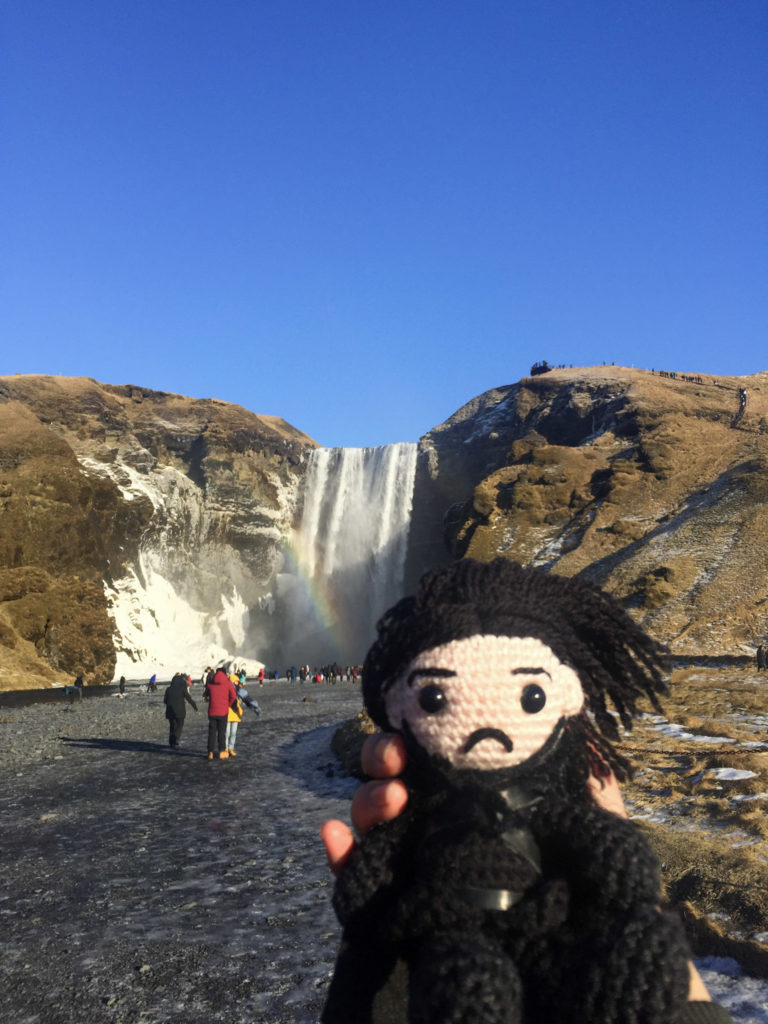
Glacier Hike on Sólheimajökull
A highlight of the day, if not the entire tour, is the glacier hike on Sólheimajökull.
The glacier hike is the one activity I’ve not exactly been dreading, but I have worried whether my fitness level is up to it. I don’t want to be the person straggling along at the rear, too out of breath to put one spiked foot in front of the other.
Fortunately, I needn’t have worried.
Preparing for the Hike
We start by getting outfitted with glacier-trekking equipment—a helmet, harness, ice axe and heavy-duty spikes that are grown-up cousins of the regular ones we wear to navigate the parking lots.
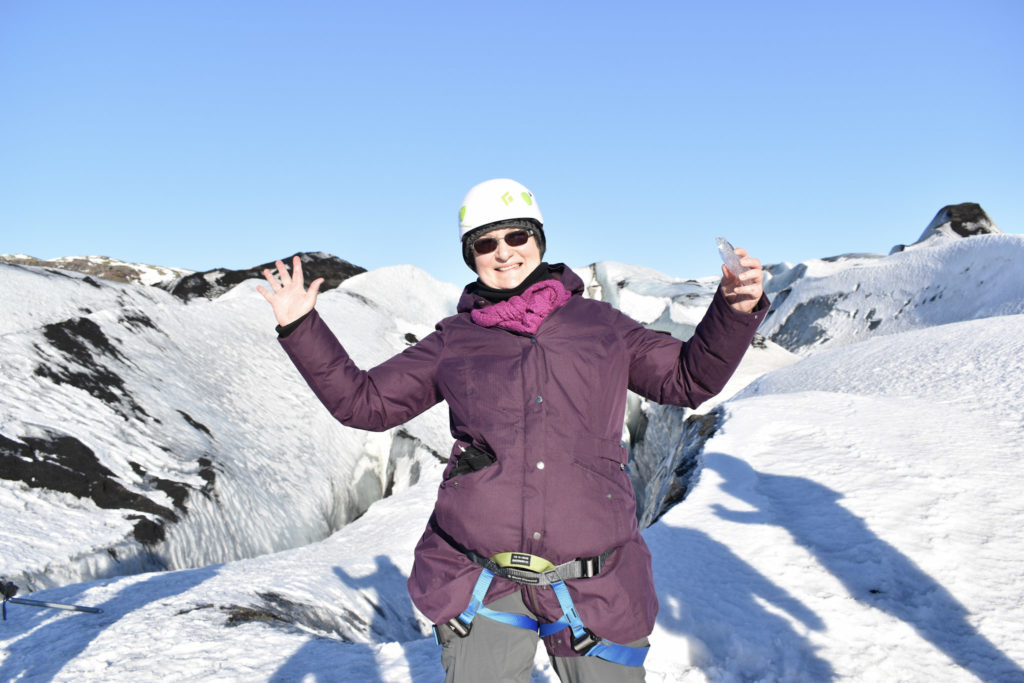
We put on our helmets and harnesses then carry our axes and spikes across a lava field that in the 1990s was feet deep in glacier. The rapid rate at which the glacier has receded in the past twenty years is sobering, to say the least. What would have been a two-minute walk from the parking lot to the lip of the glacier in the 1990s is now a good twenty-minute trek alongside a glacier lagoon over a rough, lava-strewn field.
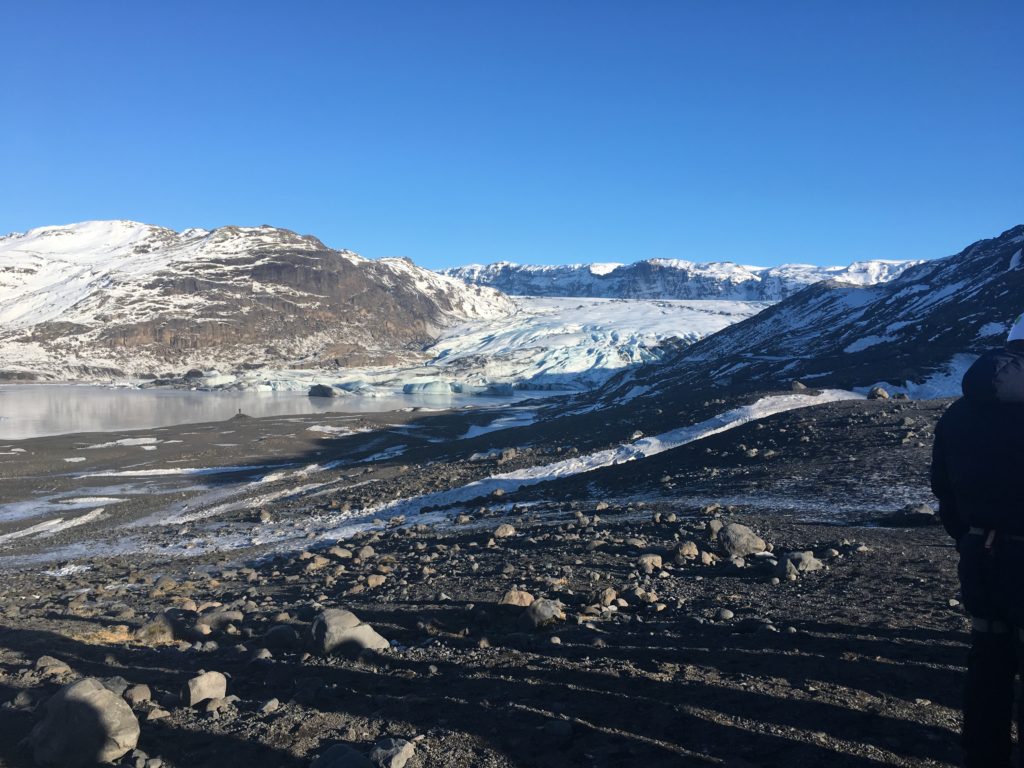
When we are almost to the glacier, we put on the spikes—a surprisingly involved process—and then hoist our ice axes. Feeling exceedingly rugged and outdoorsy, we set off toward a path cut into the side of the ice.
Climbing up the Glacier
Our guide, a delightful young Swedish woman named Sara, walks at a sedate pace that I find very manageable. So far so good. We begin our ascent of the glacier. She teaches us to “walk like an angry troll” in the spikes—feet well apart, each step strong and decisive. I keep saying “angry troll” to myself as I crash each foot down and feel the spikes dig reassuringly into the slush and ice.
Thanks to the spikes, I soon relax and marvel at the incredible otherworldly beauty rising all around us. The ice is sprayed with black volcanic ash in some places, white and tinged blue in others. I am very small against the immensity of ice rising all around me.
We stop frequently to take photos and to let the slower walkers catch up. I am relieved that I’m not one of them.
The paths we ascend are just steep enough to get the heart thumping and breath coming in short gasps, but not so steep that I regret coming. The exercise feels good after so much bus-sitting. Finally, we emerge into brilliant sunshine on top of a world of vast, frozen magnificence.
We are extremely lucky with the weather. Sara tells us that it’s not uncommon for visitors to see nothing more than the back of the person walking in front of them.
We can see for miles!
Eating Ice on a Glacier
Sara applies her ice axe to a flank of the glacier and breaks off pieces of it that she hands around to us. Glacier water is the purest in the world—especially in Iceland. We hold the pieces up and take photos through it then suck the exquisite coldness.
We spend several minutes on the glacier, snapping photos and enjoying the spectacular view. Sara tells us that the day before, the group couldn’t see anything beyond the person directly in front of them. We can see for miles.
Going down the steep path cut into the ice is more challenging than going up, but I learn that the spikes are to be trusted. I step heavily and lean back as instructed. My knees and thighs get a wonderful workout.
Reynisfjara Beach
Our last stop of the day is world-famous Reynisfjara Beach. Here, tourists have been swept away by the ferocious waves, often on days when the ocean appears calm. Our guide warns us repeatedly to NEVER turn our back on the ocean no matter how calm it looks. People have done so to take selfies and have been swept to their deaths.
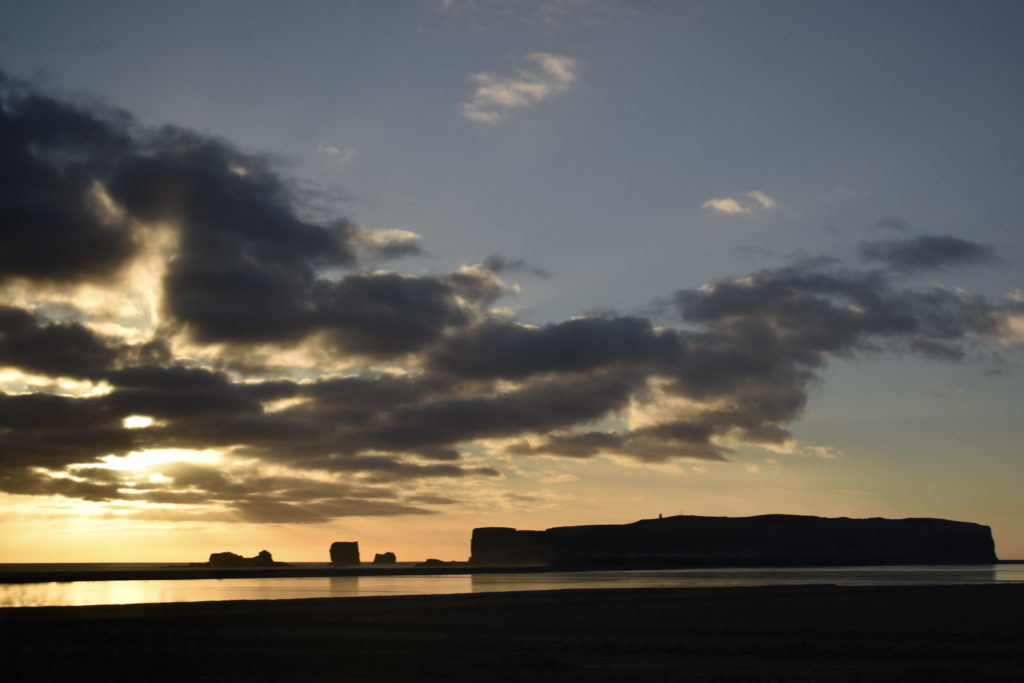
Thus soberly warned, we don’t venture any closer than about 30 meters from the water’s edge. Instead, we pose on the basalt columns and snap numerous photos of the sun setting over jagged black rocks poking up from the sea.
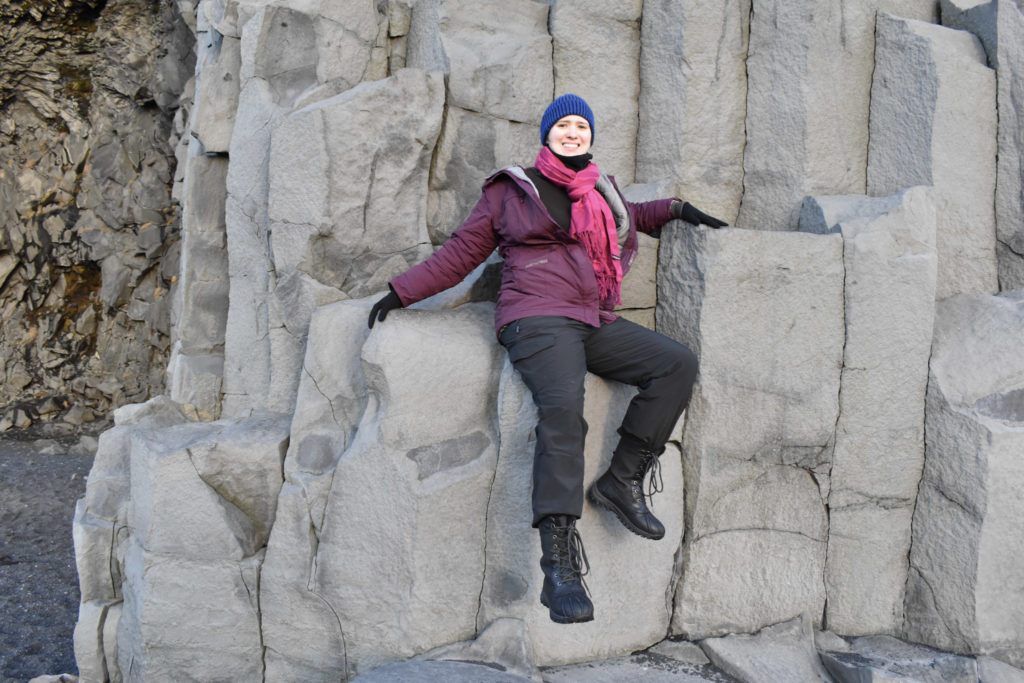
Vik
As the sun sets on Day 2, we drive to the village of Vik where we stock up on snacks and souvenirs. A few of the people on our tour load up on bags full of groceries including cartons of eggs and even a large bottle of ketchup.
We can’t figure out how they plan to cook their food since so far as we know, none of the hotels have kitchens. I suppose they must have managed somehow. We never saw them in the dining area for the entire duration of the tour.
Evening at Hotel Katla
The Hotel Katla is the most rustic of the hotels we stay in during the tour, but it’s clean and comfortable and includes a dining room with food that isn’t quite as pricey as we find in most of the other hotels.
We venture into the hot tub in the evening but it is unfortunately not quite hot enough to cancel out the freezing air temperature, so we retreat to our room for a quiet night.
Day 3: Jokulsarlon & Ice Caving
We’re pretty stoked about our impending visit to an ice cave! I mean, how often do you get to visit an ice cave carved into the side of a glacier? Not very.
On our way to Skaftafell National Park and the Vatnajokull glacier—the largest in Europe—we travel across the black sand desert of Skeiðarársandur. The weather is glorious—to our left gleaming glaciers and steep ridges, and to our right the ocean waves glinting under a blazing sun.
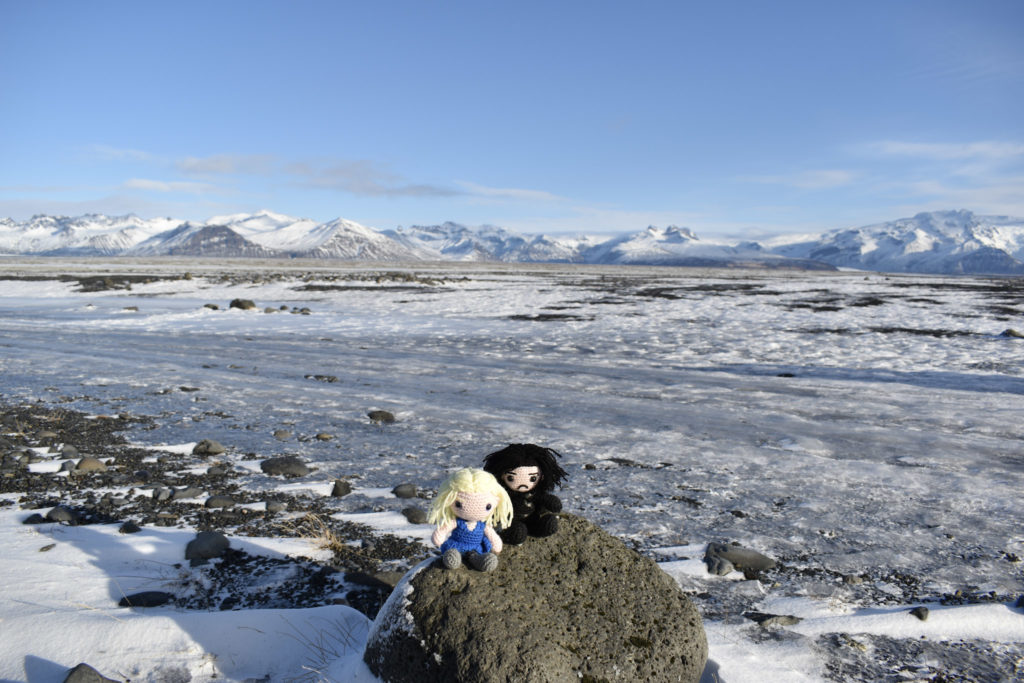
Our guide again informs us that we are very lucky to have sun. It’s not uncommon for trips along the south coast to be cancelled because of “life-threatening weather.”
We stop frequently to enjoy the views and take pictures. But each stop is a new exercise in terror. One inattentive step lies between me and an extended stay in an Icelandic hospital, not to mention inconveniencing the other 14 passengers.
Sheets of ice stretch in all directions in the parking lots—sometimes sprinkled with black sand, but never enough to counteract the slick danger. I walk like a penguin—each step carefully placed in a waddle of fear. Every so often, a frisson of sheer terror vibrates from ice to leg to core when I feel my feet slipping.
Historical Exhibitions
Kirkjubæjarklaustur
We stop by two visitor centers on our way to the ice caves. The first is an informative exhibition near the marvellously named Kirkjubæjarklaustur (often shortened to Klaustur) about the disastrous eruption of Lakagígaror Laki in 1783.
I’m fascinated by the film called “The Fire Mass” that centers on the effect the eruption had on the local farmers. The volcano erupted from June 1783 to February 1784, spewing over 42 billion tons of lava into the air along with clouds of poisonous gasses that led to the deaths of over 50% of Iceland’s livestock, not to mention 25% of the human population.
The 1783 eruption had far-reaching and global consequences. Among other things, the eruption caused the famine in France that led to the French Revolution.
On both of our days in Iceland’s most volatile geologic region, I’m reminded how vulnerable we are as a species. If any one of the currently active volcanoes were to erupt, air traffic could be disrupted not for weeks, like it was during the Eyjafjallajökull eruption in 2010, but for up to 18 months.
All communications would be wiped out as the deadly ash spews into the upper atmosphere. The effect on our food supply would be catastrophic. In some ways, the hard-scrabble farmers who lived in the area in 1783 were better off. At least they had crops and animals to eat for the first month or two before the toxicity levels made everything inedible. In our modern, store-dependent lives, we’d last maybe a week on canned goods before starvation set in.
And no Internet? It doesn’t bear thinking about.
Vatnajokull Visitor Center
We also pop into the Vatnajokull Visitor Center to enjoy another informative film (I’m a sucker for them) about the area and how it changes from season to season. Several enticing trails start at the Visitor Center which we hope to explore when we return in summer.
When, not if!
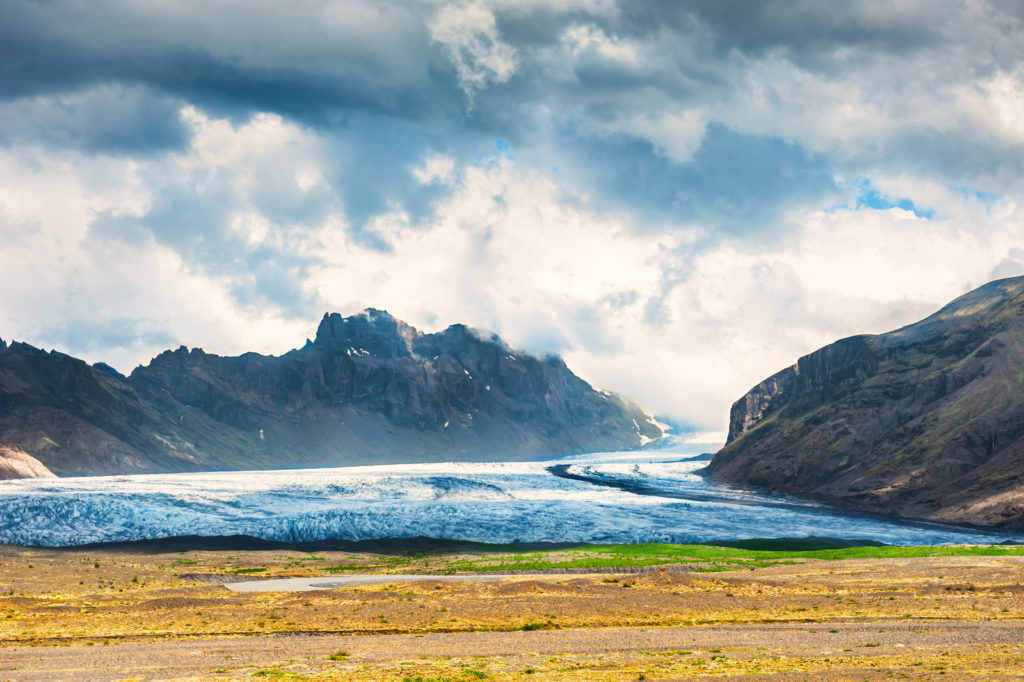
After a quick lunch of a fresh and delicious smoked salmon baguette, we press on to the ice cave experience, stopping at yet another ice-slick parking lot. This one is so bad that Jon pulls the bus to within two feet of the entrance to the glacier bus.
Even with just two feet spanning the distance between the two doors, everyone needs the help of both guides to jump across. This is one slippery country in winter!
Ice Caving
The glacier bus is about the same size as our tour bus, but with very large tires designed to get the bus up, onto, and over the glacier. Our new guide keeps up an interesting and amusing commentary while driving onto the glacier.
The drive to the ice caves takes a good 15 minutes across a spectacular snowscape. Dazzling blue sky above, turquoise-tinged ice below, massive fields of snow-covered moraine all around. The bus lurches and rumbles along the track.
The view is beyond belief—ice and snow, lava and glaciers, endless sky puffed with white clouds.
We’re on top of the world.
Preparing for the Ice Cave
When we stop, the guide sternly reviews the drill. First, we are to put on our helmets in the bus. Not outside the bus. In the bus. We are not to step outside the bus until we have our helmets on. No exceptions.
He warns us, repeatedly, to NEVER take our helmets off from the moment we step from the vehicle onto the ice until we return. Like, NEVER. He is very, very insistent.
If we are caught taking our helmet off, we will get a severe reprimand. If we do it twice, we will be sent back to the bus, ice cave tour over. He repeats the directions so many times that I’m wondering just how often people dare to defy him.
We comply, of course (hey, we’re Canadian), and firmly affix our helmets to our heads.
Stepping onto the Ice
With exquisite care, I step out of the bus onto sheer ice. No wonder the guide insisted we put on our helmets before getting off the bus. A fall would crack open a human head like it’s a watermelon. In this blue and white world, red would not be a good look.
I have to shuffle just three feet from the door of the bus to where the guide is handing out our heavy-duty, super-duper, industrial-strength spikes. I’m not sure I can make it and hug the side of the bus, taking tiny steps.
As the guide hands out the spikes, he exhorts us to hold them and do nothing. He breaks off to yell at a man in the group who has dared emerge onto the ice sans helmet. Boy, does the guy get a tongue-lashing. Being on the receiving end of an angry Icelander is not my idea of fun.
The ice cave guide tells us later that he has five children and has absolutely no problem being the bad guy if it means keeping everyone safe. I get it.
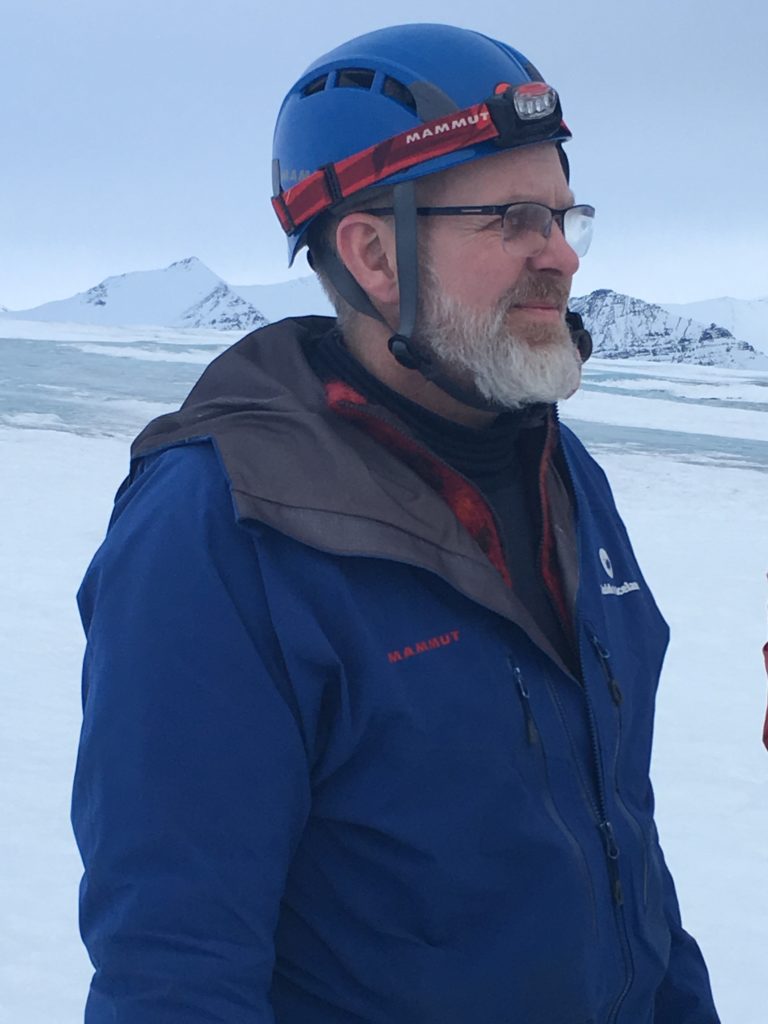
Another person in the group starts putting on the spikes after being told not to do anything until directed. Sigh. There‘s one in every group. In our group, there are two.
She is told to remove the spikes and to listen to his directions.
Setting Off for the Ice Cave
Finally, we are all correctly helmeted and spiked. We set off across the glacier toward the ice cave, following the guide in single file.
The wind whips up with stinging efficiency. I dig in my spikes, walking like a mountain troll the way we were taught on the glacier the day before. Left, right, left, right—legs wide apart, feet planted with decisiveness. There’s no mincing about on a glacier.
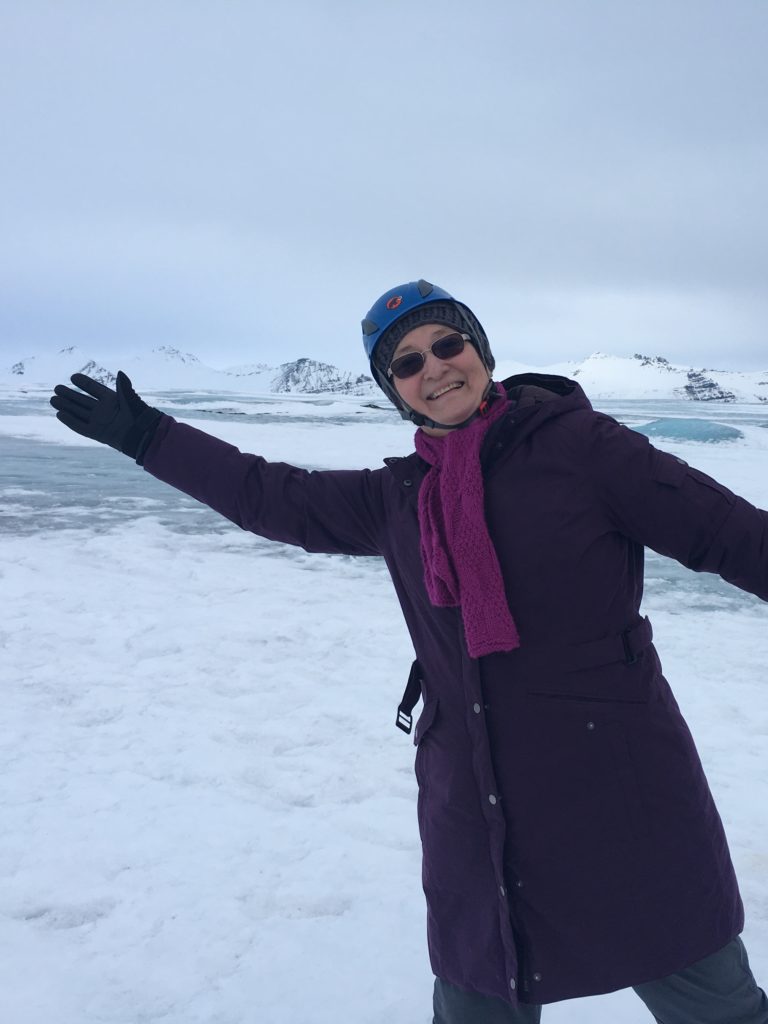
The trek to the ice cave takes only about ten minutes across a ridge from which we have a glorious 360-degree view of the glaciers. In the distance is the site of one of the Game of Thrones scenes. Julia is impressed.
Entering the Ice Cave
We arrive at a set of snow steps leading down to the ice cave. I have seen pictures but really have no idea what to expect. We descend one by one into a land of such pristine, crystalline beauty that I can only stare in awe.
The ice cave is white and light blue and gray and black-flecked and deep blue. The surfaces are smooth and pock-marked, bubbled and streaked. The guide tells us to touch the ice, to feel it melt under the heat of our fingertips. Everyone is snapping pictures, and I do too, pausing every so often to just stand and be one with the otherworldly beauty.
The cave is small – only about eight meters long and two meters wide, just big enough to comfortably fit fifteen people all taking pictures at the same time and to still be able to take pictures that include only ice.
The guide yells again, this time even louder than before. Despite being warned earlier, one of the women has removed her helmet for a photo op. Oh dear!
After the cave, we take turns sliding down a small hill. Here’s a video of Julia.
Jökulsárlón Glacier Lagoon
We visit the lagoon and the black sand beach. Both are spectacular, particularly the lagoon, famed as one of Iceland’s most iconic spots. Icebergs that have broken off from the glacier Breiðamerkurjökull float into the lagoon and out to the ocean.
We spot seals lounging on the icebergs and sliding in and out of the water like kids at a waterpark.
Fosshótel Vatnajökull
Our night is spent at the lovely and very modern Fosshótel Vatnajökull, way out in the countryside. An early night is in order to recover from all the ice-caving excitement.
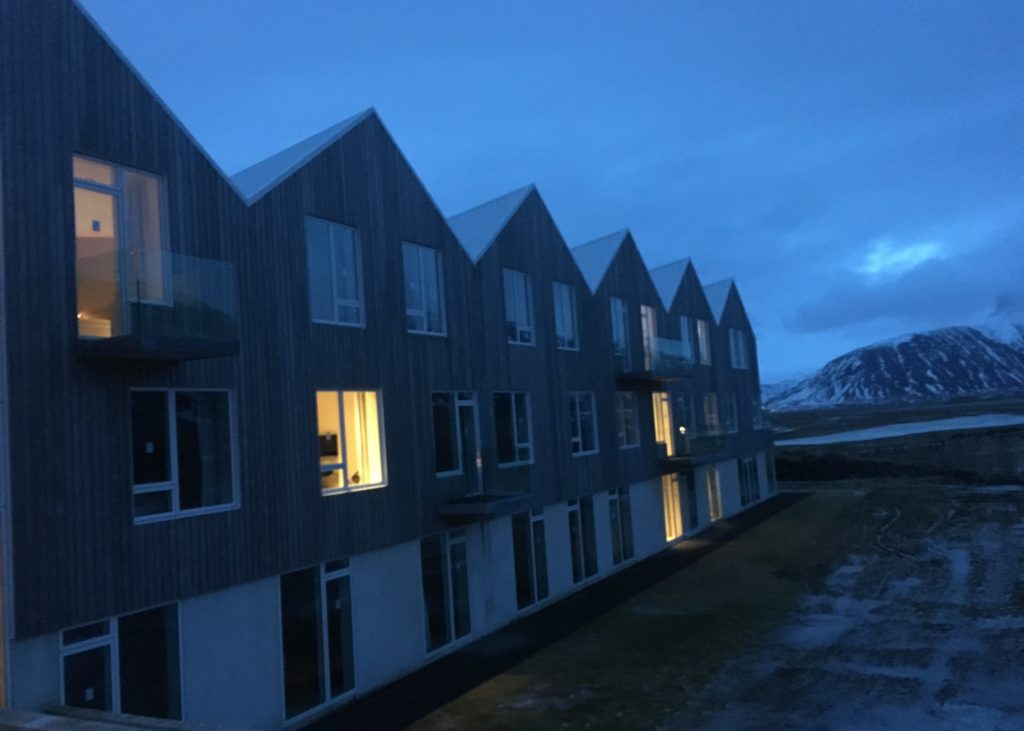
Day 4: The Eastfjords
After three days of glorious sunshine, we drive into rain on Day 4. The Eastfjords are apparently spectacular—deep fjords carved into the mountainsides, wild reindeer roaming the hills, charming coastal villages. We don’t see much of the mountains, but we do see quite a few herds of wild reindeer which is pretty exciting.
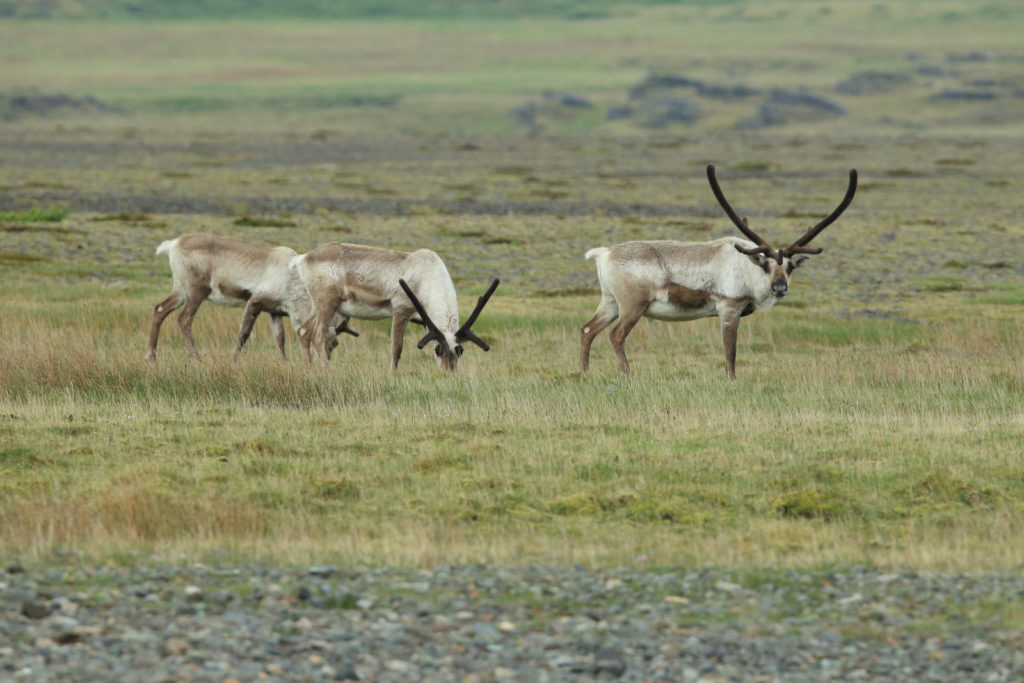
I definitely want to return to this area when the weather is better. It’s one of the least-touristed areas in Iceland and still feels very wild. We wind around fjord after fjord, stopping in a few of the villages, including this one with an interesting art installation.
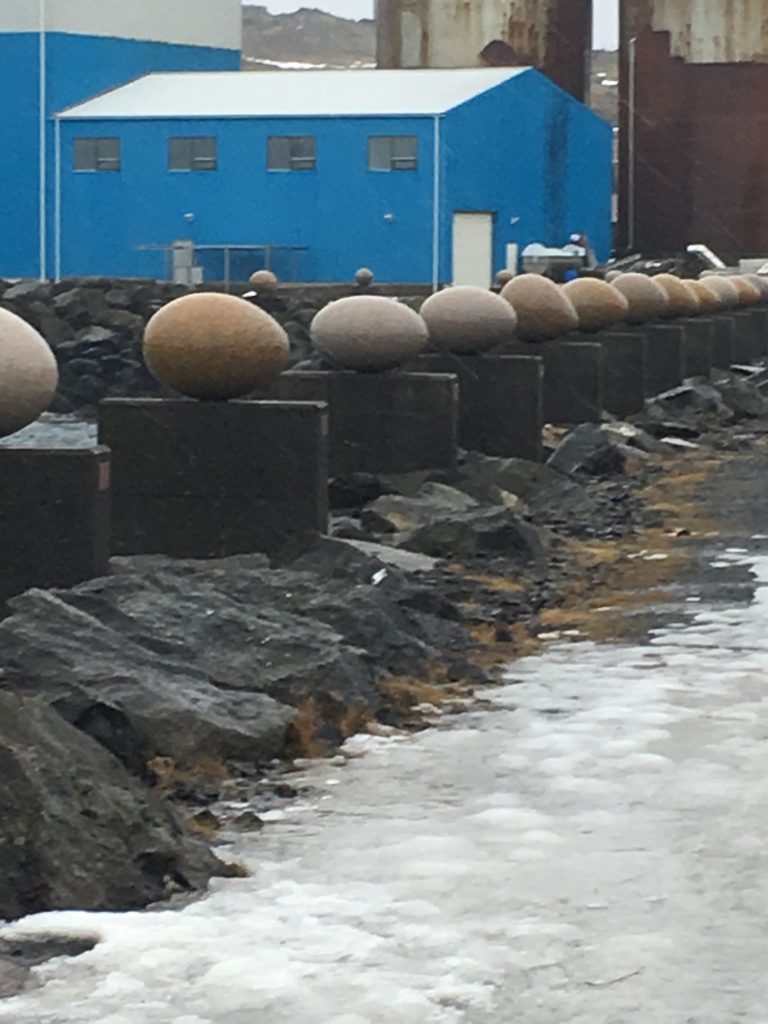
Lake Hótel Egilsstaðir
The sun bursts out just as we arrive at the charming Lake Hótel Egilsstaðir. As its name suggests, the hotel overlooks Lake Egilsstaðir which is ice-covered at this time of year. We enjoy a walk in the sunshine over crunchy snow.
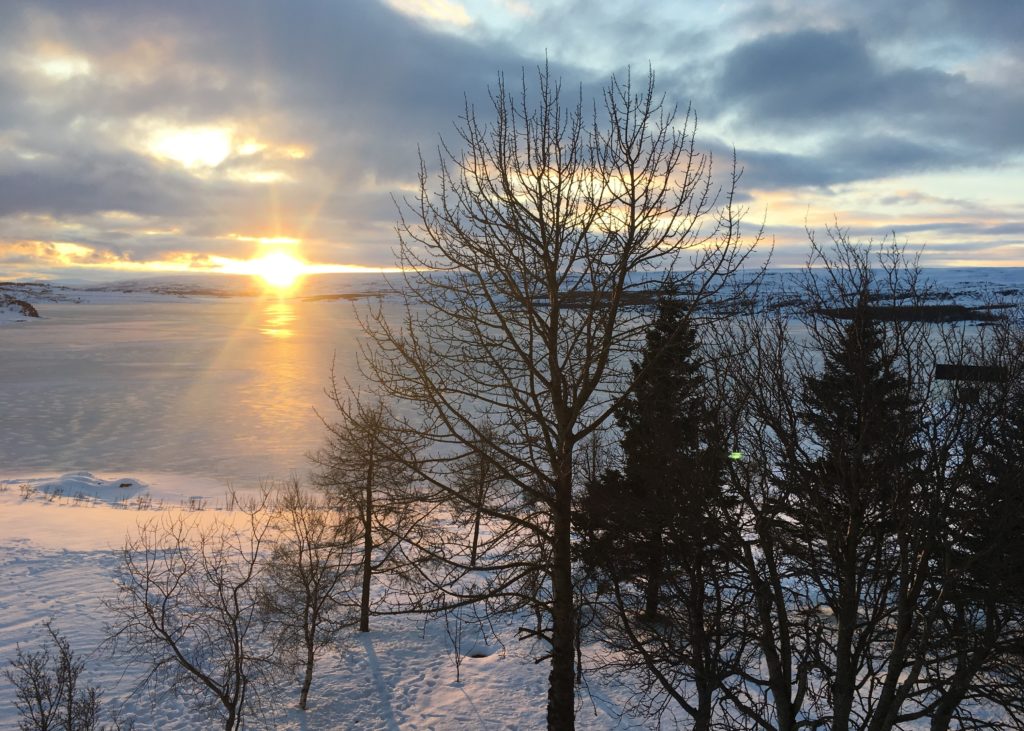
After a gourmet dinner in the hotel restaurant, we hear that the northern lights are on! Everyone piles out into the snow to watch the sky. I see a few flashes and one dancing spiral, but that’s about it. We wait for a while and then return to our room.
No worries! We still have a few days more to see the lights.
Although sightings of the northern lights obviously can’t be guaranteed, the guide does his best throughout the trip to inform us when the lights might occur.
I download the app to my phone as well and keep an eye out. Just the quick taste of them at the hotel is enough to excite us for how amazing they could be.
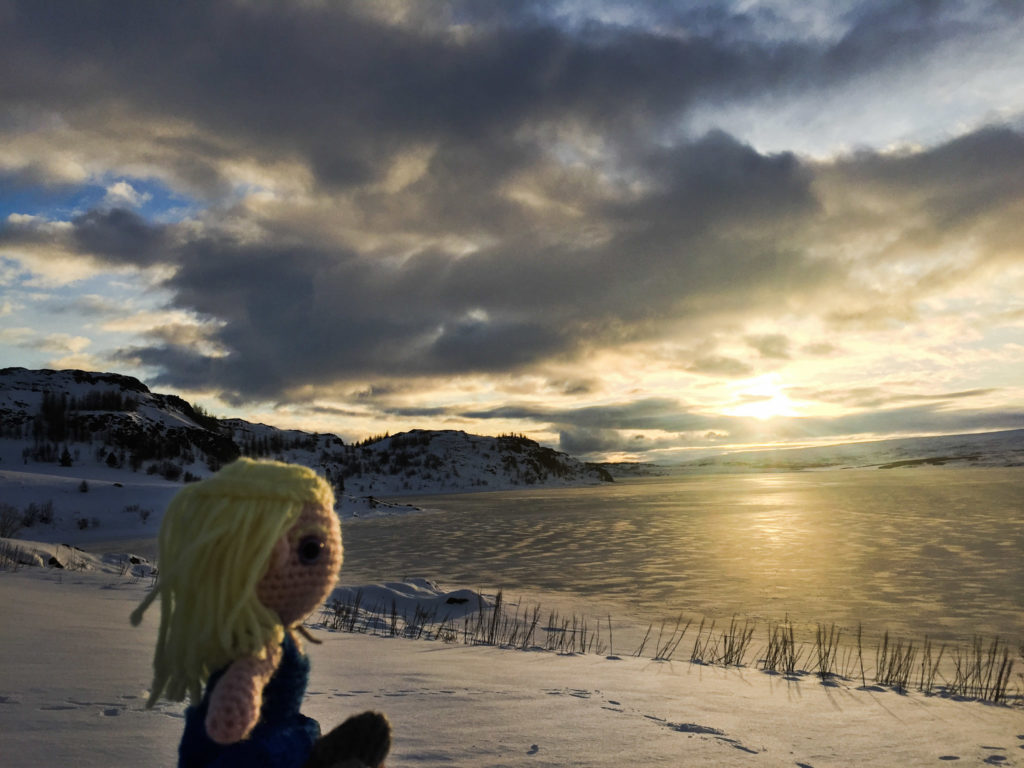
Day 5: Lake Mývatn and Dimmuborgir
So much to see today! Our destination is Lake Mývatn and a late afternoon dip in the Mývatn Nature Baths—northern Iceland’s answer to the Blue Lagoon.
Dimmuborgir Rock Formations
Julia is really looking forward to visiting these strange rock formations. Dimmuborgir means “dark castles” and was the setting for several scenes in Game of Thrones. According to legend, this area is home to the hidden people whom many think still exist.
Learn more about Icelandic folklore and the elusive elves by attending Elf School in Reykjavik. It’s on my list for my next trip.
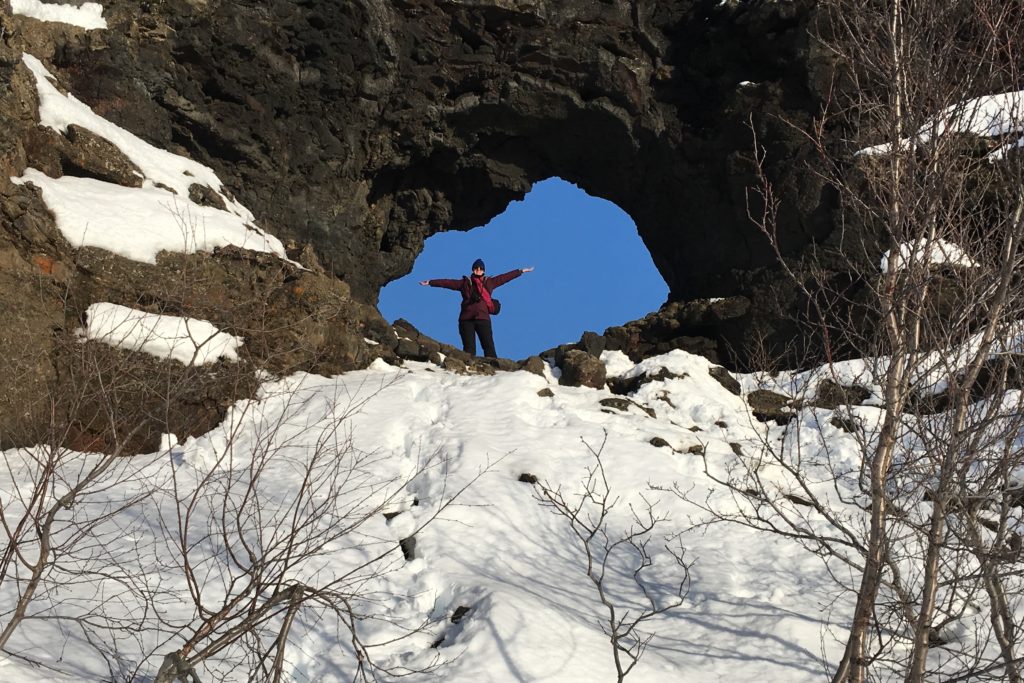
We are again lucky with the weather. The fantastical rock outcroppings, many dusted with fresh snow, rise starkly against a sparkling blue sky. The air is very cold and crisp, and the pathways winding around the formations are virtually tourist-free. We almost have the whole place to ourselves.
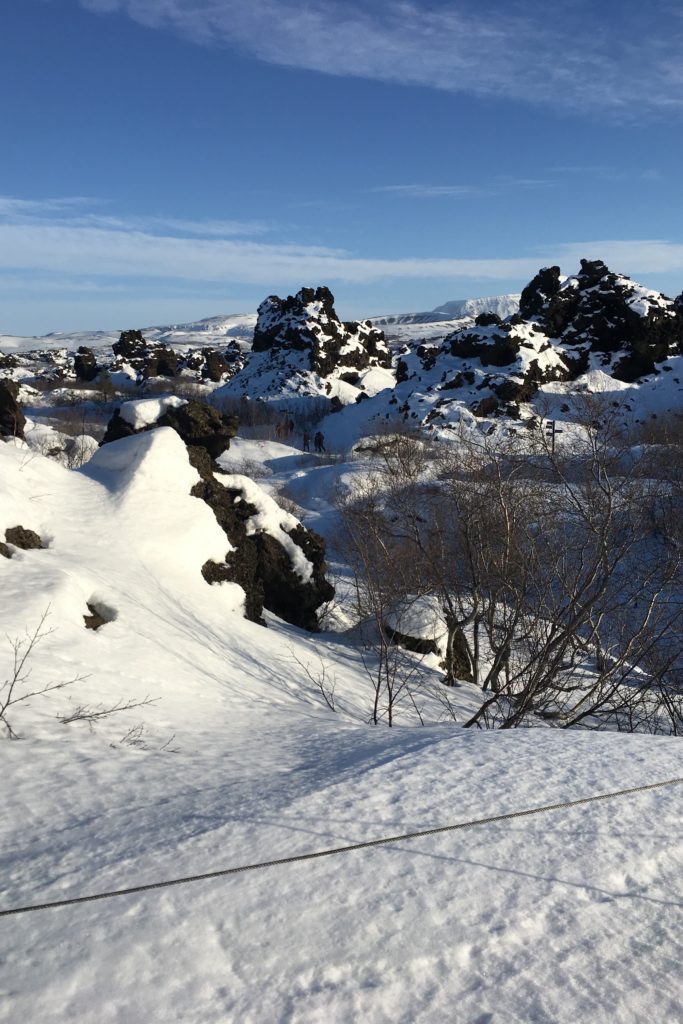
Námaskarð Thermal Area
I’m very taken with this geothermal area of bubbling mud pools and steaming fumaroles. The rust-red earth is streaked with rainbow colors under shifting clouds of steam. Blasts of warmth cut through the chilly air.
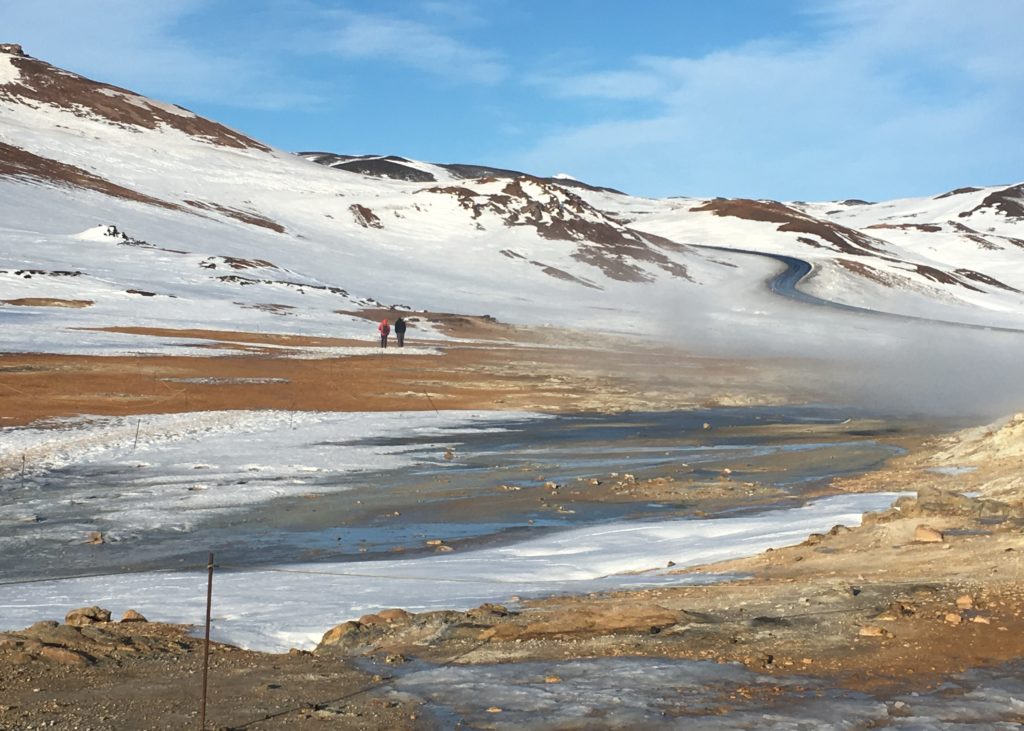
In the summer, the area is crowded, but today, the parking lot contains just a few cars and small tour busses. Here’s a 360-degree view of the area. As you can see, it’s stunning!
Goðafoss
A foss is a waterfall and Goðafoss is one of Iceland’s finest. This Waterfall of the Gods (Goða means “gods”) tumbles over a wide escarpment.
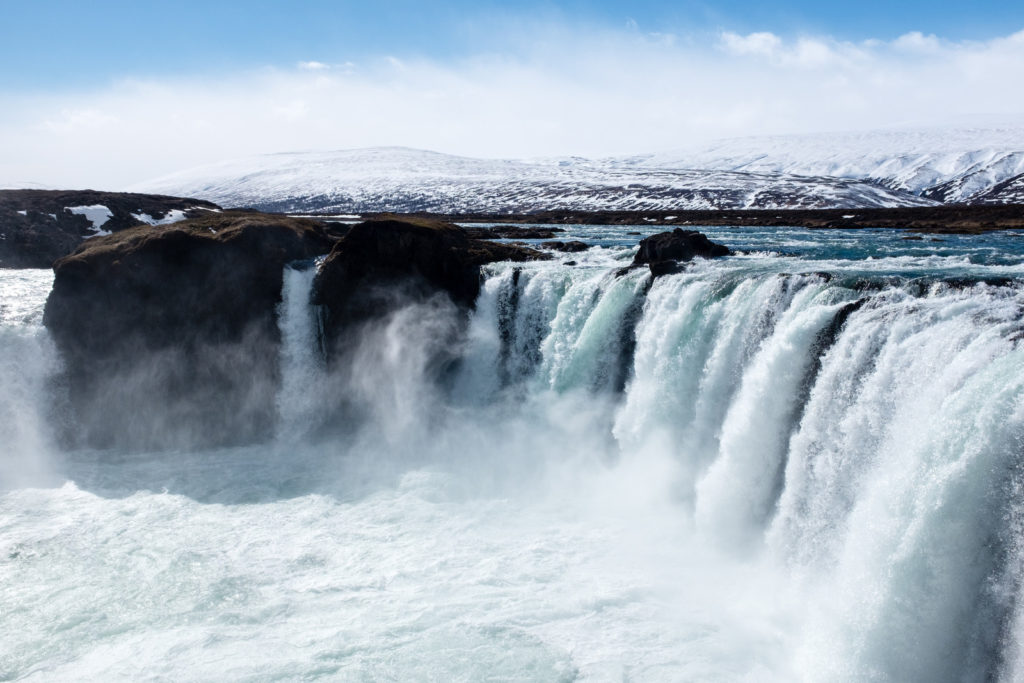
A legend published in the 19th century describes how in around the year 1000, the lawspeaker Þorgeir Ljósvetningagoði made Christianity the official religion of Iceland. To seal the deal, he supposedly threw his statues of the Norse gods into the waterfall.
Mývatn Nature Baths
We circle Lake Mývatn (“Fly Lake”). In the summer, the area is hopping but is also, as the name suggests, a haven for flies. In February, the flies are all sleeping so we can enjoy the dramatic volcanic scenery around the lake in comfort.
The day ends with a visit to the Mývatn Nature Baths. This is an optional add-on – not everyone joins in, but most do.
The Mývatn Nature Baths are not particularly extensive and not nearly as large as the Blue Lagoon. For that reason, I’m not sure I’d want to visit in summer when the crowds get thick. But in winter, a visit there is a fabulous experience.
The excitement starts in the changeroom when, along with everyone else, I am required to strip naked and wash in the communal shower. A diagram highlights the areas to wash—underarms, feet, and you-know-where. The Icelandic people are not shy. Having a naked shower and then pulling on a dry swimsuit is an exercise in contortion but I finally manage it and make my way to the exit.
Entering the Mývatn Nature Baths
The distance from the warm interior to the warm pool is about 10 meters—10 meters of frozen wasteland in a gusting wind. I take a deep breath, fling open the door and tippy-toe as quickly as possible down the incline and into the pool.
Ahhhhh.
The warmth! The wind! Oh no—the wind! It gusts across the water, churning white caps and making us feel like we’re tossing on an angry sea—which we kind of are.
From the neck down, all is warmth and happiness. But from the neck up, exposed skin is blasted with a frigid squall. I don’t dare duck under all the way. For one thing, I’m not sure that’s wise in a hot spring and for another, I intuitively sense that exposing wet hair to cold wind might not end well.
Enjoying the Mývatn Nature Baths
I am distracted by the view. Stretching before us for as far as we can see is a misty expanse of snow-dusted lava ringing a sheet-white lake. In the distance a perfect cone pierces a sky already edging toward sunset although it’s just 4 pm.
Steam rises from the baths and is blown away by the wind. We are in a science fiction world of ice and fire, hot and cold. We bob around in search of warm spots and end up hanging out with some other people from the tour near an intake point.
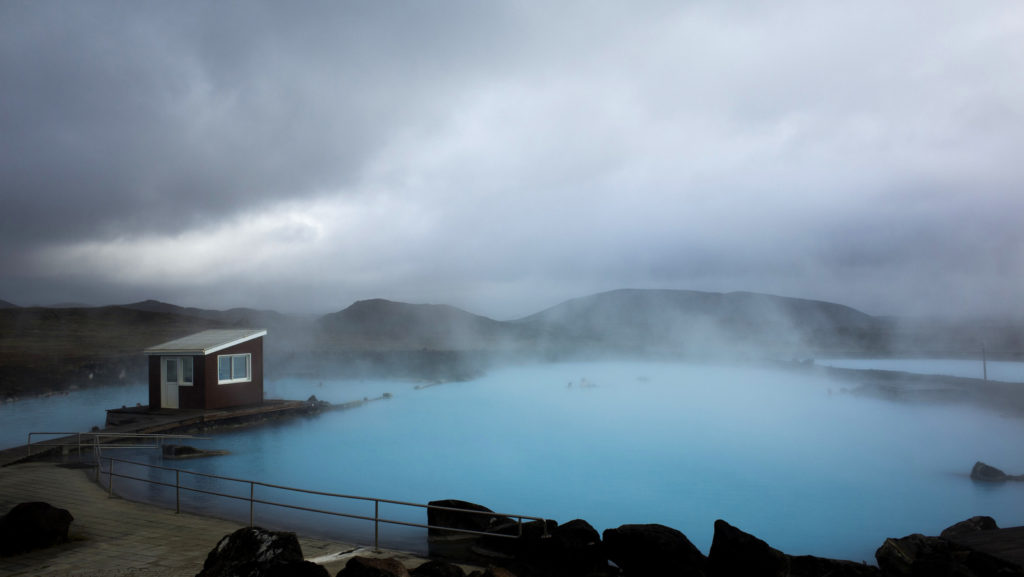
The water in the Mývatn baths is 100% natural from the earth with no chemicals added. The water is not salty and thick like it is at the Blue lagoon. Although the pong of sulfur permeates the air, I find it less obnoxious than the heavy smell of the Blue Lagoon that eventually made me feel ill. For my account of our morning at the Blue Lagoon see Iceland’s Blue Lagoon: Should You Go?
Two waterfalls of warm water pound down close by. I bob over and submit to a massage over my shoulders and let my head get wet. The wind has died down and I no long feel in danger of contracting pneumonia.
Across a barrier is a second large pool of marginally cooler water. We climb out of the hot pool and dash across the narrow barrier to the cool pool just because we figure the warm pool will feel even warmer after the cool pool.
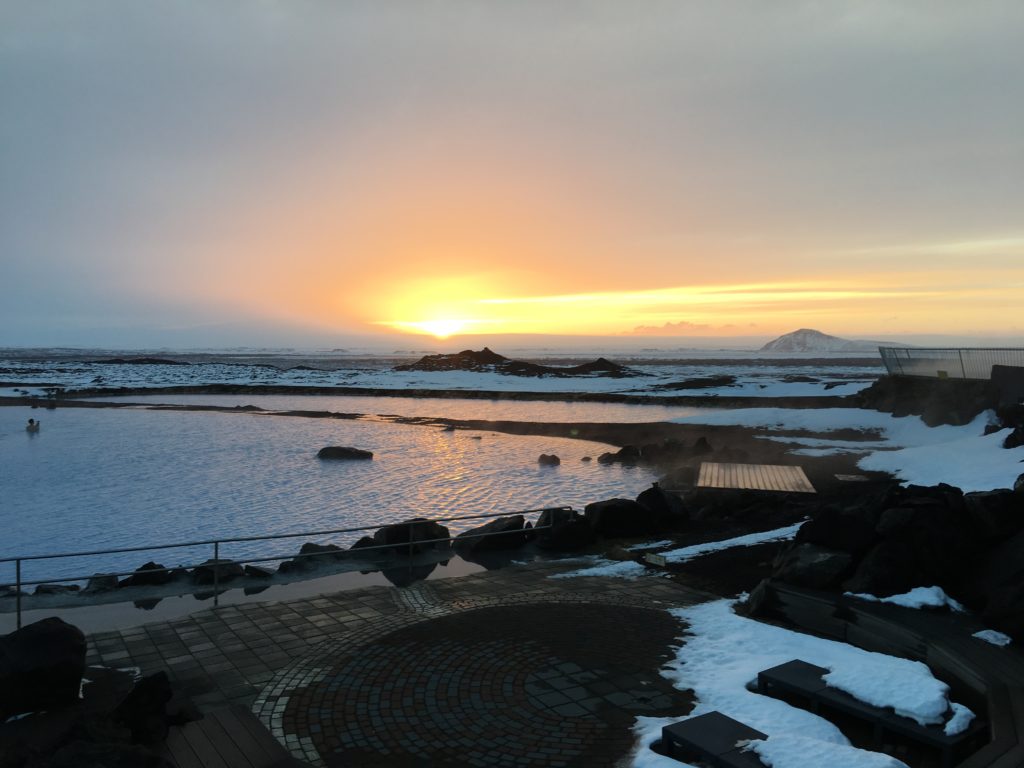
The cool pool is closer to the view and feels like it drops off into infinity. The snow-dusted lava rocks ringing it add drama to the scene. This ain’t your normal swimming hole.
Our last stop is the hottest pool—a long, thin affair heated to 41 degrees. We clamber in and give ourselves over to several more minutes of bliss while the sun sets in earnest. By the time we get out, the setting sun is coating the steaming water with gold. We struggle out of wet bathing suits and into outdoor clothes, faces glowing red.
Mývatn vs. the Blue Lagoon
If Iceland can be said to have a tourist controversy it would be Mývatn versus the Blue Lagoon. Which is better? Should you go to both? Or should you go to just one—and if so, which one? Or neither?
My considered opinion, having gone to both, is to visit the Blue Lagoon first, just because it’s pretty amazing if you haven’t done Mývatn, and then do Mývatn second because it’s so much better than the Blue Lagoon.
On the other hand, if you go to Mývatn first, then don’t bother with the Blue Lagoon, because it’s more crowded, way more expensive, and just a tad overwhelming. That said, I’m very glad I experienced the Blue Lagoon fresh off the plane. It is an experience, for sure, whereas Mývatn is just good, clean fun.
Fosshotel Mývatn
The Fosshotel Mývatn is gorgeous. Perched high on a hill overlooking the lake, the place is modern and well appointed. In fact, every Fosshotel we’ve stayed at during the trip is wonderful. When I return to Iceland, I’ll be booking them again.
When we check in, we’re asked if we’d like a northern lights wake-up call. We say yes and hope the call won’t come in the middle of the night.
The Northern Lights
The call comes at 9 pm. Battle stations! We leap into our warm clothes (it’s really cold out!) and clump out to the parking lot. The hotel is perfectly situated for northern lights viewing. There are no other structures within miles and it’s high on a hill.
The ice underfoot is black and slick and deadly. I pause to put on my spikes and waddle out to be amazed. And yes, I am amazed—eventually. At first, a faint band of pale green stretches across the sky. I think it’s a cloud but am informed that no—it’s the northern lights. I am disappointed but resolve to stay outside a little longer.
A few more glimmers of green appear in the sky—impressive but not really blowing me away.
The Northern Lights Deliver
Several minutes later, the northern lights switch themselves on in earnest, and the parking lot echoes with squeals of delight. iPhones click, and the serious photographers with tripods and primed aperture settings bend to their viewfinders. Julia sets up her mini tripod on a convenient ledge and starts snapping.
I raise my iPhone to the lights and snap away but I get nothing. Apparently, my phone isn’t up to the task so I shove freezing fingers back into my gloves and resolve to just enjoy myself.
The lights begin to dance—swirling and spiraling and pulsing. The sky is alive with bright green and white and the occasional flashes of light pink at the base near the horizon. Halfway through the show, we join the woman from Quebec and set off across the frozen parking lot to slog up a snow-covered hill to a ridge.
We have a 360-degree view with a full moon shining behind us and the lights sweeping in a broad arc in front of us. The cold brightens my cheeks and slices through the thin material of my pants. We’d gotten ready in such a hurry that I’d neglected to put on my usual two layers—long johns and snow pants.
All the static shots I’ve seen of the northern lights have not prepared me for the movement. We stare awestruck at the gyrations. My pictures don’t even begin to do the show justice! Here are some stock pictures of the northern lights that give you some idea of their brilliance.



The Northern Lights in Norse Legend
At the Aurora Museum in Reykjavik, we’d read the scientific explanations for why the sky bursts with joyful abandon at certain times of the year. But I prefer to believe the ancient Norse explanations.
Here’s one of several.
Back in the day, Odin was the chief god and ruler of Asgard, revered by all Vikings. Odin’s task was to prepare for a series of events called Ragnarök that would presage the end of the gods. In Viking legend, Ragnarök was to be Odin’s greatest battle for which he needed the bravest warriors.
Enter the Valkyries – female warriors on horseback who wear armor and carry spears and shields. The northern lights are the reflections of the Valkyries’ armor as they lead Odin’s chosen warriors to Valhalla.
Isn’t that more interesting than charged particles from the sun striking atoms in the Earth’s atmosphere, causing electrons in the atoms to move to a higher-energy state, then dropping back to a lower-energy state and releasing a photon: light to create the northern lights? Or so I’m told.
Day 6: Northern Iceland
Today, we drive to Akureyri, Iceland’s second city. On the way, we stop for coffee and waffles at a dairy farm. The friendly owner takes some of us into the barn to see the very well-fed and contented cows.
Akureyri
And then it’s off to Akureyri for an afternoon of wandering around the shops while some of the tour group go whale watching.
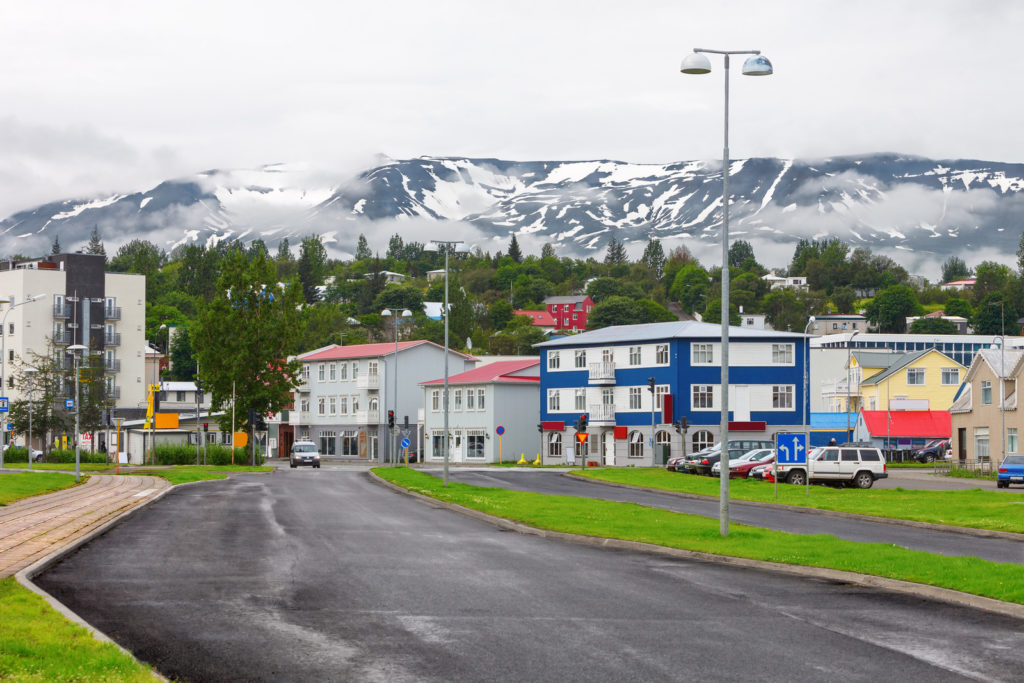
The weather is wet and dreary and there’s not much to see in Akureyri so this day is the least exciting of the tour. I look forward to returning in summer when we can explore more of the small coastal villages in the area.
Kjarnalundur Hotel
Perched on a hill several kilometers outside Akureyri, the Kjarnalundur Hotel is not as well appointed as some of the other hotels we’ve stayed at. We eat take-out food bought in Akureyri and spend the evening doing not very much. No more northern lights!
Day 7: West Iceland and Snaefellsnes Peninsula
We start the day by driving along the north coast toward Snaefellsnes Peninsula. Jon tells us about his extensive experience with Icelandic horses, and we stop at a horse farm to get up close and snuggly with a few of the horses. I can’t get enough of the endearing little guys.
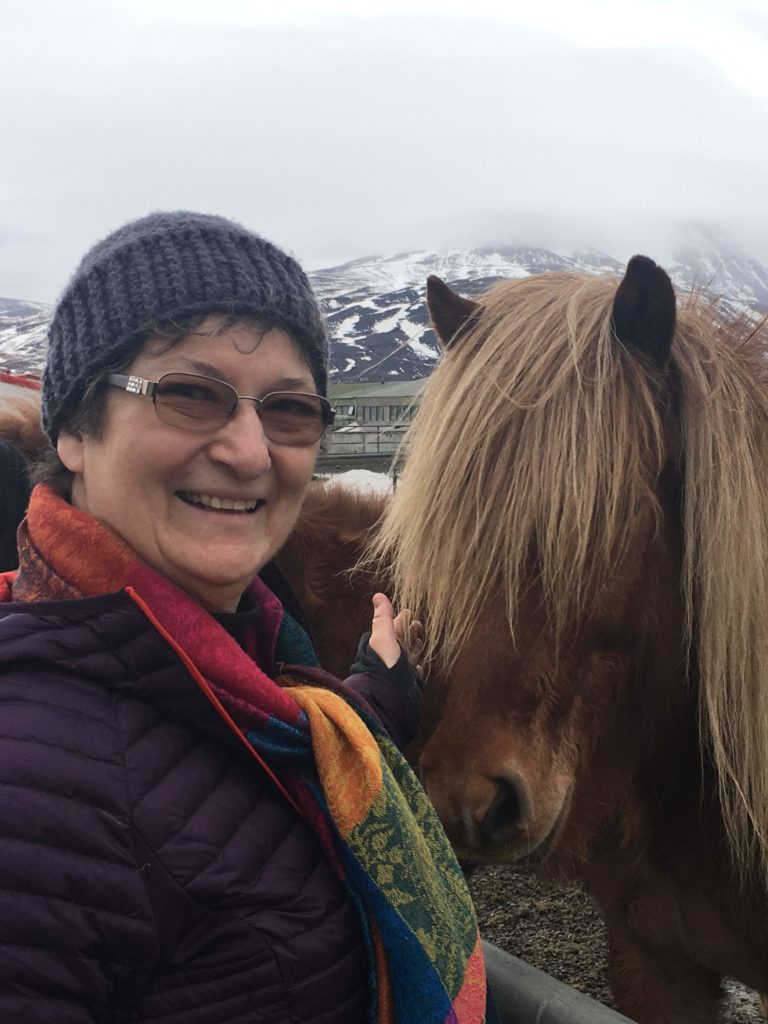
Jon was born in the area and entertains us with plenty of stories from his youth. We also stop to view the statue of Gudrid Thorbjarnardóttir who was born in Snæfellsnes in 980 and during her lifetime took eight sea voyages and traveled twice across Europe as far as Rome. Read more about her in Artsy Sightseeing on the Iceland page.
Deildartunguhver Hot Springs
We stop near Reykholtsdalur to view yet another wonderful thermal area at Deildartunguhver, the highest flowing hot springs in Europe. The water here is HOT—a constant 97 degrees Celsius (207 degrees Fahrenheit). Wooden walkways line the hot springs and we learn how much of the water is used to heat Icelandic homes.
More Waterfalls: Hraunfossar and Barnafoss
I’m not yet tired of waterfalls which is a good thing because Iceland sure has more than its share! Both of the waterfalls we visit are completely different and both are stunning.
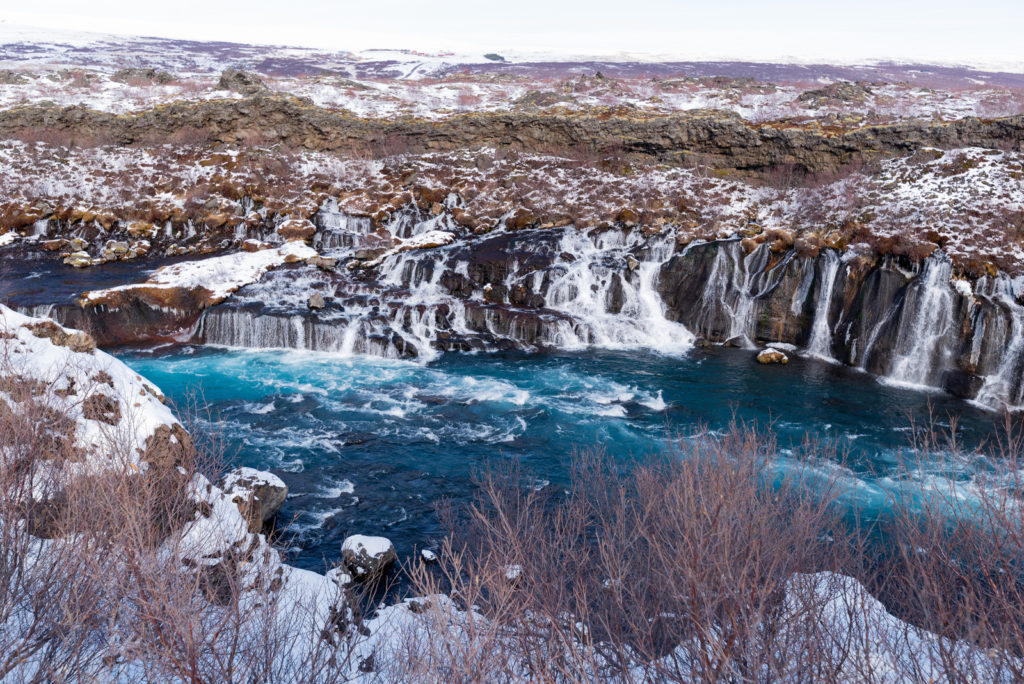
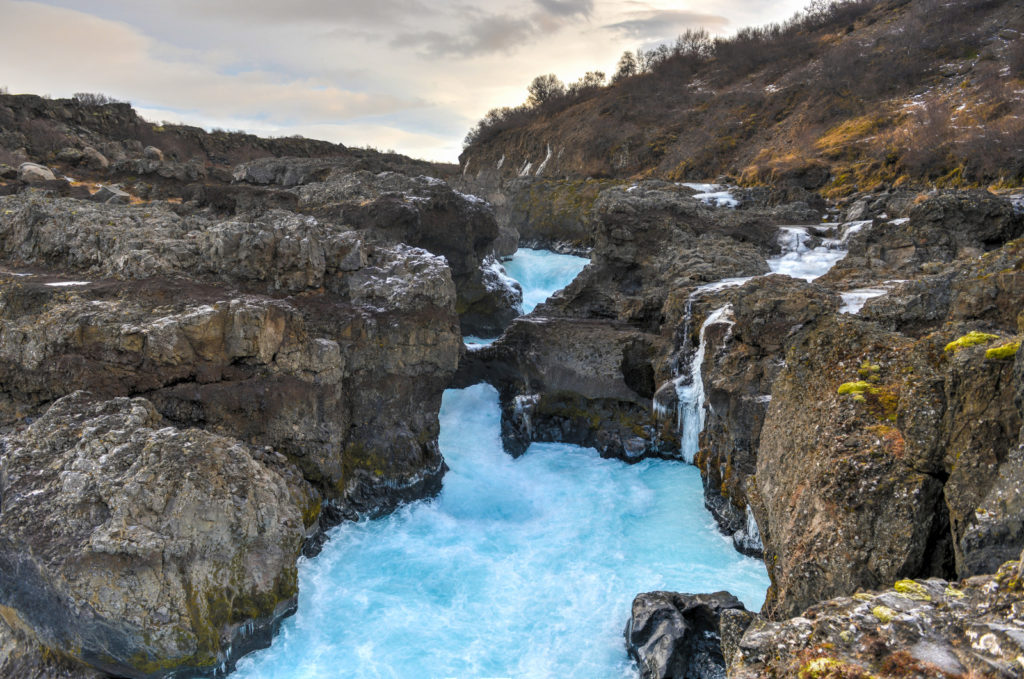
Reykholt
We stop for the night in Reykholt, home of the great Snorri Sturluson who in Iceland is as revered as Shakespeare is in the English-speaking world. Read more about him in Artsy Sightseeing on the Iceland page.
Fosshotel Reykholt
The Fosshotel Reykholt is one of the best—modern, well appointed, and efficiently staffed. In the evening, we enjoy drinks with some of our tour mates, something we haven’t done much of during the tour.
Day 8: Snæfellsnes Peninsula and Return to Reykjavik
Today, we head farther west to the fabled Snæfellsnes Peninsula for a full day of spectacular scenery. Snæfellsjökull, a massive glacier-capped volcano, dominates the skyline as we drive into the Snæfellsjökull National Park, one of only three national parks in Iceland. The stratovolcano beneath Snæfellsjökull is 700,000 years old.
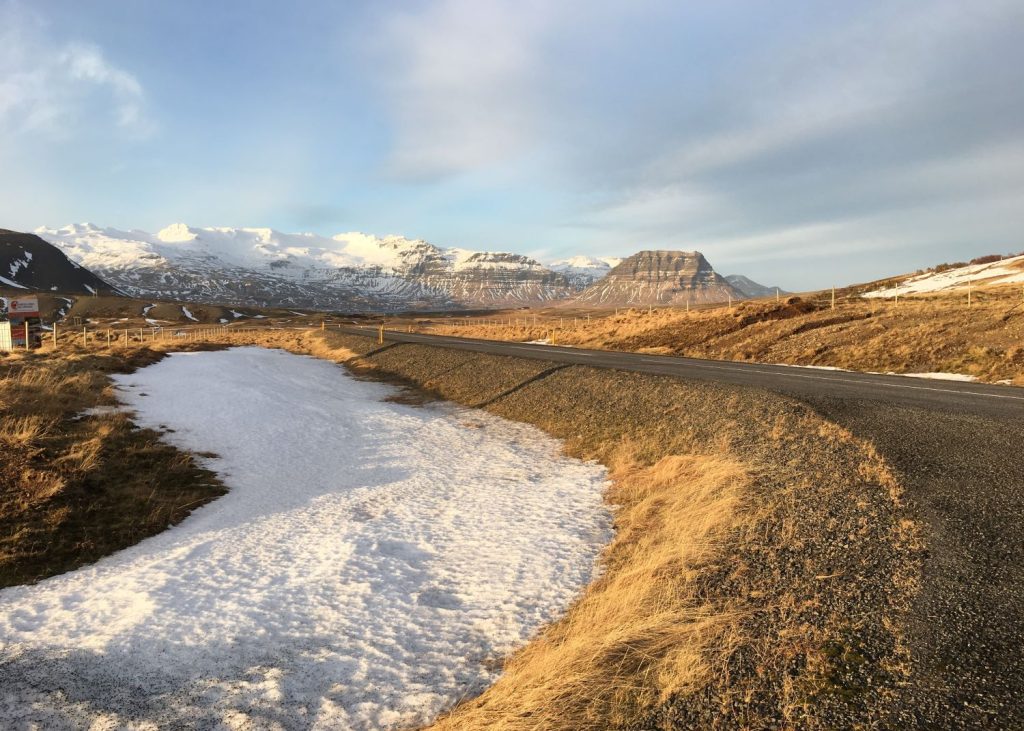
Kirkjufell
A highlight for Game of Thrones fans—and anyone, really—is the iconic Kirkjufell, otherwise known as Church Mountain. Note that “kirk” means church and “fell” means mountain.
Its distinctly shaped peak is probably the most photographed mountain in all of Iceland. And no wonder!
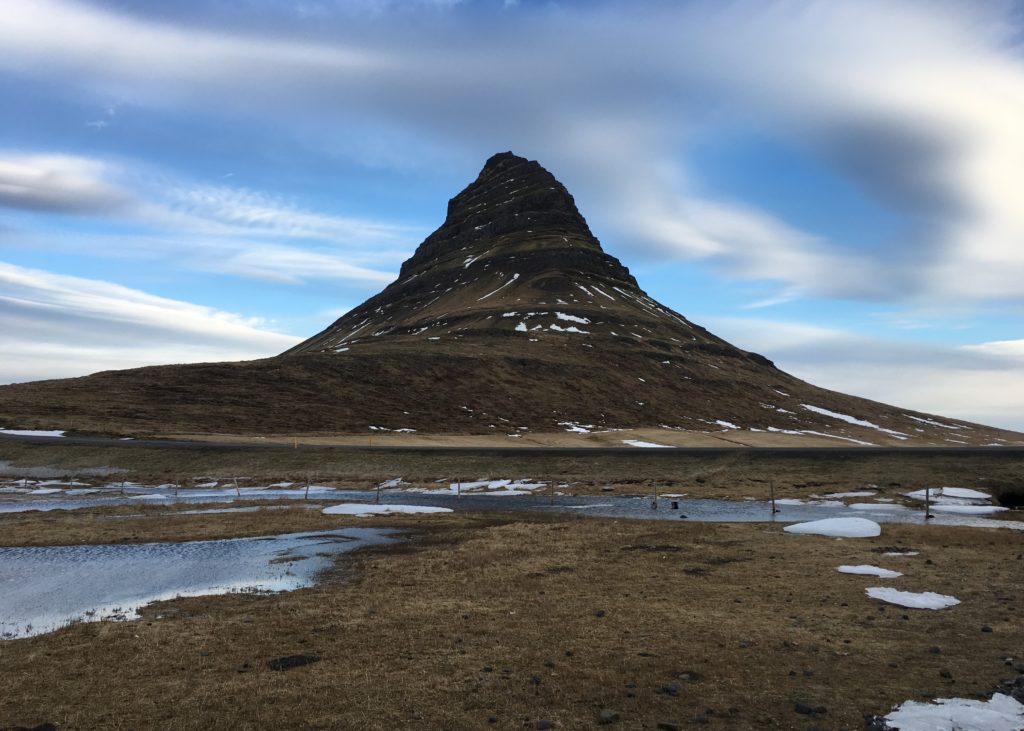
We’re lucky to be able to park close by and snap several good photos. In the summer, the small parking lot gets overwhelmed with visitors, and the traffic is bumper to bumper along the road leading to it.
Jon gets us together for a group photo in front of Kirkjufell.
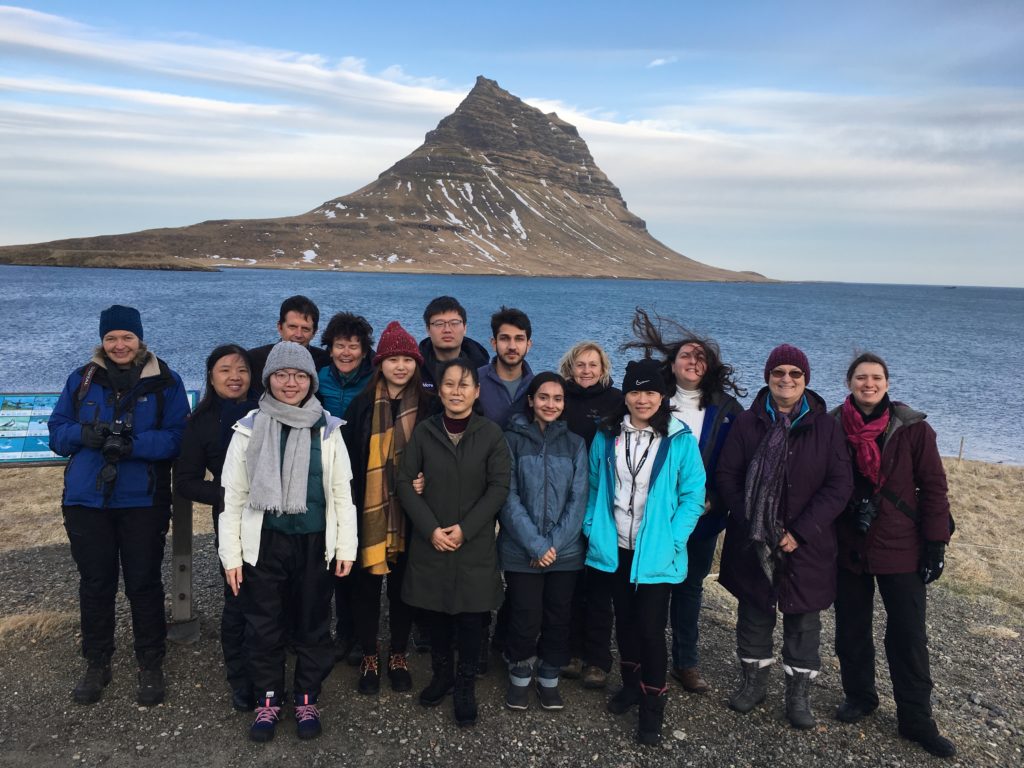
Vatnshellir Lava Cave
Our last add-on tour is of the Vatnshellir Lava Cave. Wearing helmets and carrying small lanterns, we descend 35 meters into the 8,000-year-old lava cave created by a volcanic eruption in the nearby Purkholar crater.
The entertaining guide leads us past rainbow-colored volcanic rocks and petrified lava formations. At one point, we enter a side cave and turn off our lanterns to experience a few moments of true darkness. While the black presses into our eyes, the guide sings a haunting Icelandic song.
Very evocative!
Outside, a ferocious, sleet-filled wind has whipped up, and we scurry back to the bus for the final drive to Reykjavik.
Conclusion
Our eight-day tour of Iceland provided an awesome introduction to this wonderful country and thoroughly whetted our appetites to return.
On the next trip, we’ll rent a car and explore the Ring Road at a more leisurely pace. At least two weeks is needed so we can go on a few hikes and spend more time in the Eastfjords and the north.
I’d also like to explore some of the highlands, Iceland’s spectacular and vast interior hinterland that is closed during the winter. The Westfjords region in northwest Iceland is another remarkable area that even at the height of summer is sparsely visited.
Here are some tours to consider if you’re thinking about visiting Iceland.
Have You Visited Iceland?
Please share your experiences and recommendations in the comments below!
Here are more posts about Iceland:
